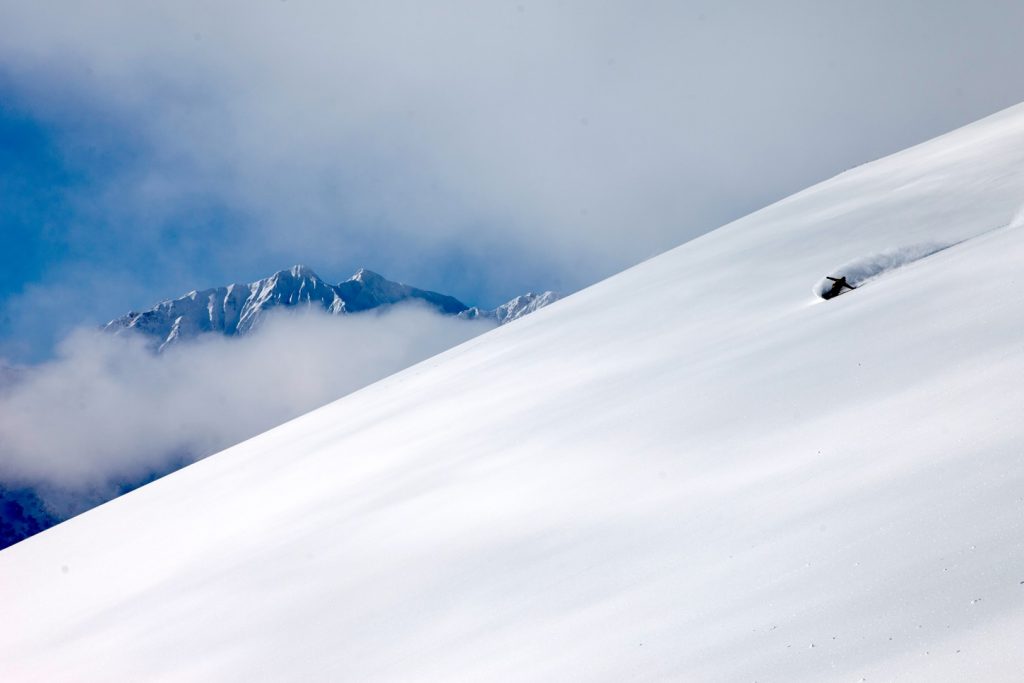One of the largest and most famous snow resorts in Japan.
CONTENTS
Trail
Riesenslalom Course
Urakuro
CORONA ESCAPE TERRACE
Ski & Snowboard School
Hakuba Ski Jumping Stadium
HAKUBA VALLEY
Epic Pass
Accommodation
Winter Glamping
Food
Green Season
Hakuba Happo-one’s Hot Spring
History of Hakuba Happo-one’s Hot Spring
Naturally Hydrogenated Hot Water
Obitana no Yu
Japanese Hot Springs: Manners and Rules
Trek Through the Chubu-Sangaku National Park
Take a Ride on the Happo Alpenline
Kurobishi Line
Hakuba Ohashi Bridge
Oide Park
Hosono Suwa Shrine
Hakuba Museum of Art
Hakuba Saegusa Art Museum
Tetsuo Kikuchi Alpine Photograph Gallery
Hakuba Chapel
Wadano no Mori Church
The Beginning of Japanese-Style Guest Houses
Hakuba Alpen Library
Hakuba Happo-one is the venue for the Nagano Olympic Alpine Skiing and boasts one of the largest ski resorts in the country. From Nagano it takes just over one hour by bus or you can take a train from Matsumoto station to Hakuba station (one transfer) which also takes just over an hour. The area is blessed with breathtaking panoramic views of Hakuba’s hugely impressive mountain range and striking beauty of excellence. Not only for the winter season, but for the green season, the city is crowded with climbers aiming for the majestic Hakuba Commonwealth. Along with the flow of the seasons, Hakuba Happo-one changes scenery variously and continues to attract visitors.
Anothernatural attraction of Hakuba Happo-one area are the Mountain and Spa Resorts (Onsen). We encourage you to visit and discover the local onsens and allow yourself to relax and take in the pleasure of our Natural Mountain Springs where our staff are waiting to offer you a warm welcome.
As a first step to accomplishing our goal, we have introduced new services to meet the needs of customers from all over the world. Moreover, we are determined to move forward and advance our hospitality services. With the relaxing effects of our heavenly Hot Springs and the variety of cuisine offered on our menus, we look forward to serving you at Happo-one.
Trail
Hakuba Happo – One is the venue for the Nagano Olympic Alpine Skiing and boasts one of the largest ski resorts in the country. The spectacular ski slopes that are close to the mountains of the 3,000 m class North Alps will have a variety of courses besides special courses such as the Mogul course and the rush course rich course. The specialties are bumps of Usagidaira slopes and Kurobishi slopes. There is the Riesen Slalom Course is a long course that can enjoy a total length of 4000 m following Usagidaira from the slope following Nagiyama Nakiyama slope. For those who come with family, we recommend Sakka slopes with kids slopes and nursery facilities.
A skiing & snowboard school with a high level, a rental shop with plentiful equipment, a rich lodging facility spreading at unique restaurant and at the foot, enriching the environment as a resort.
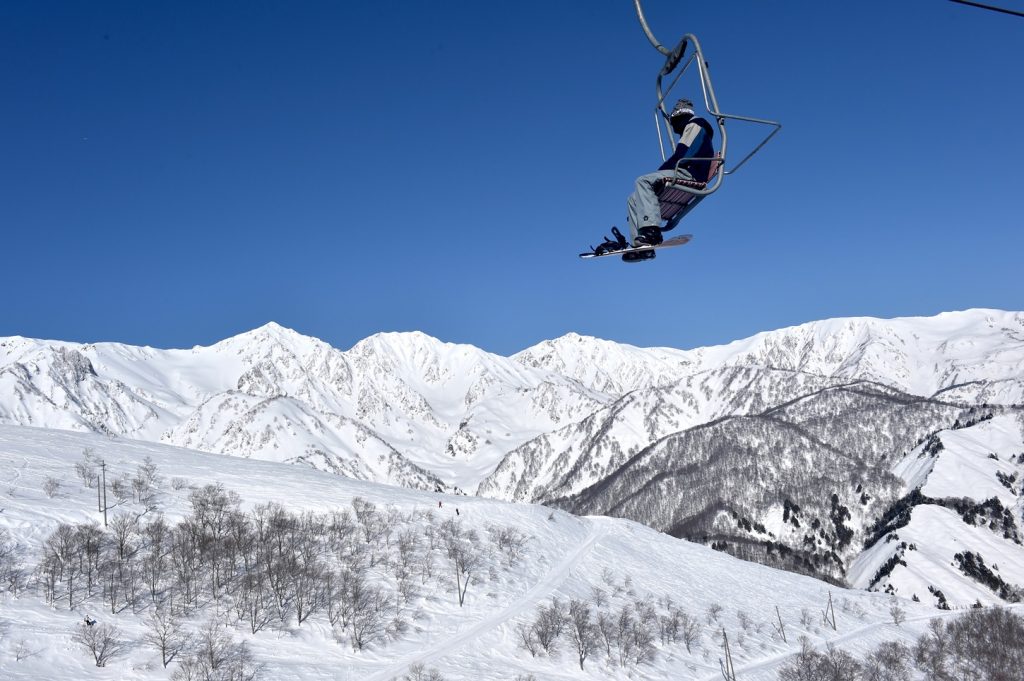
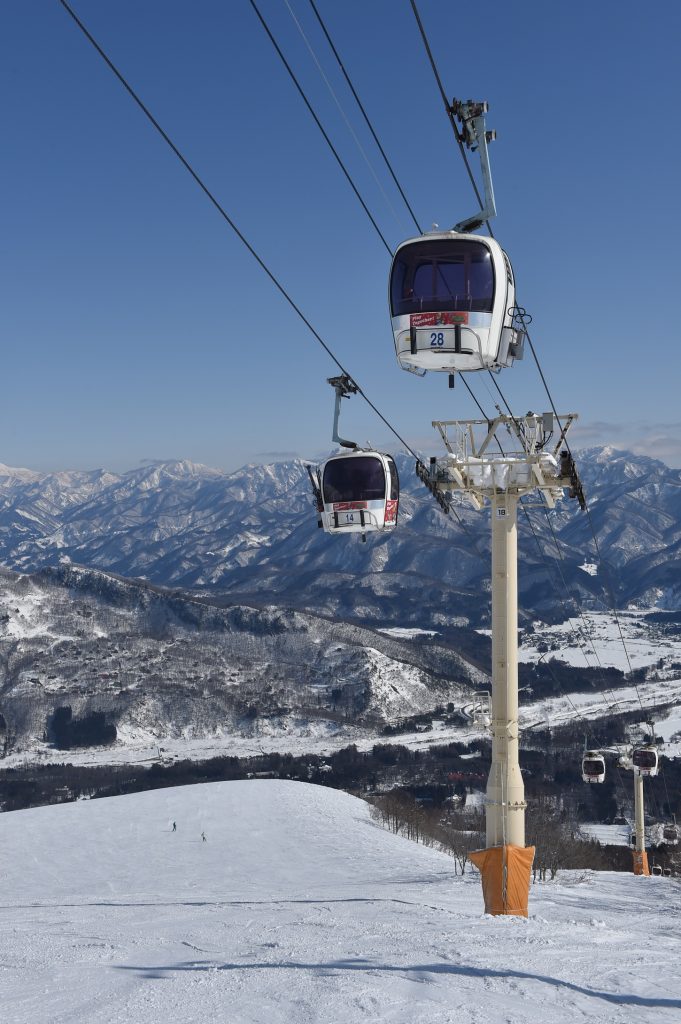
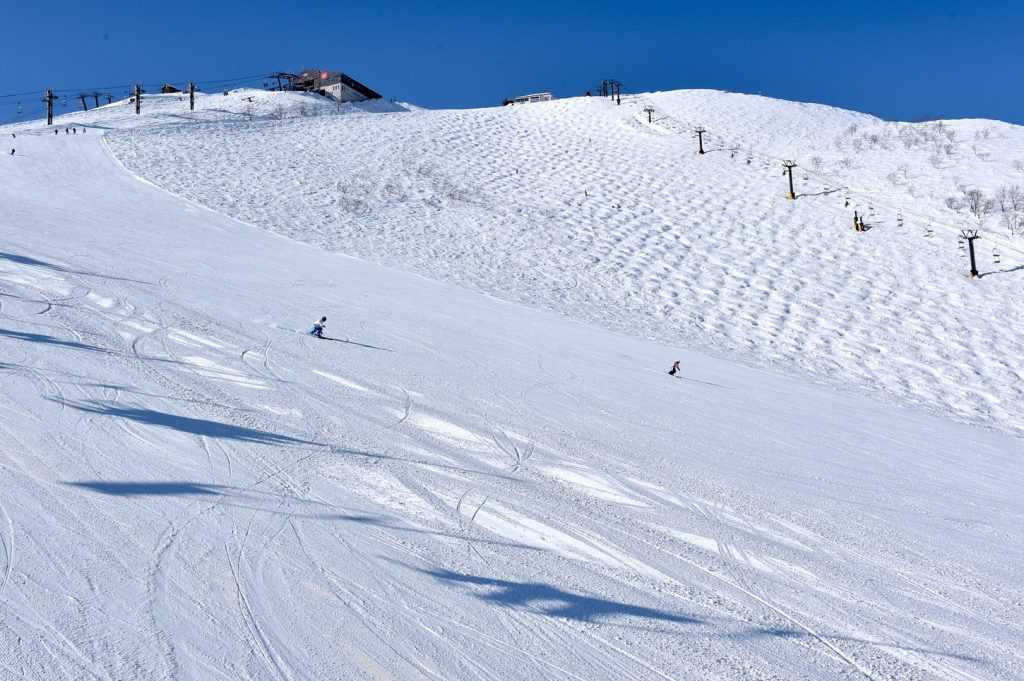
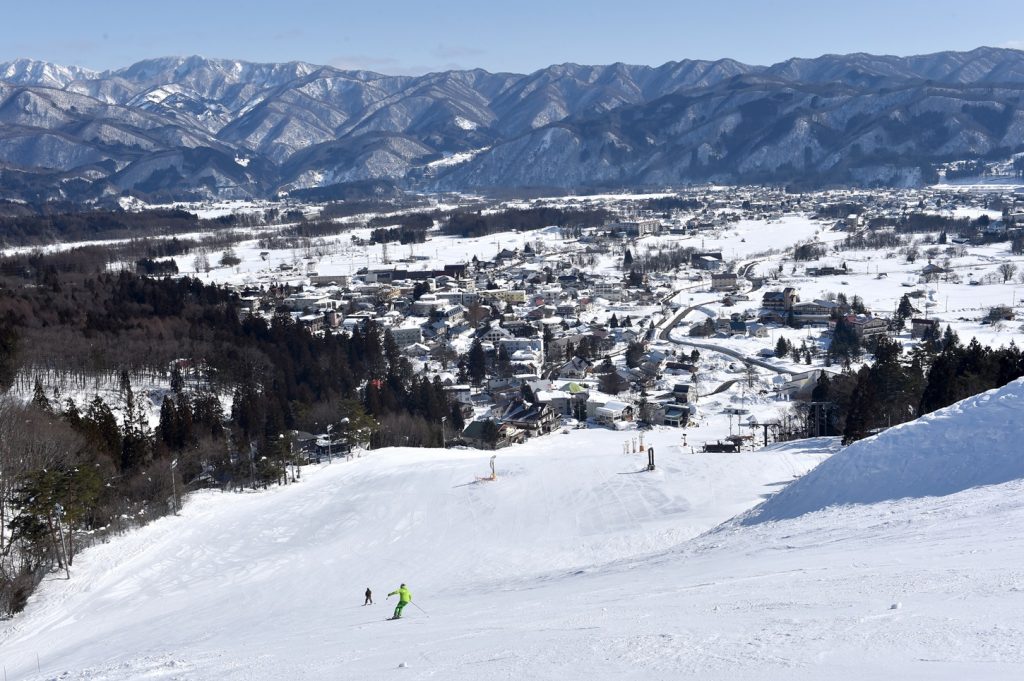
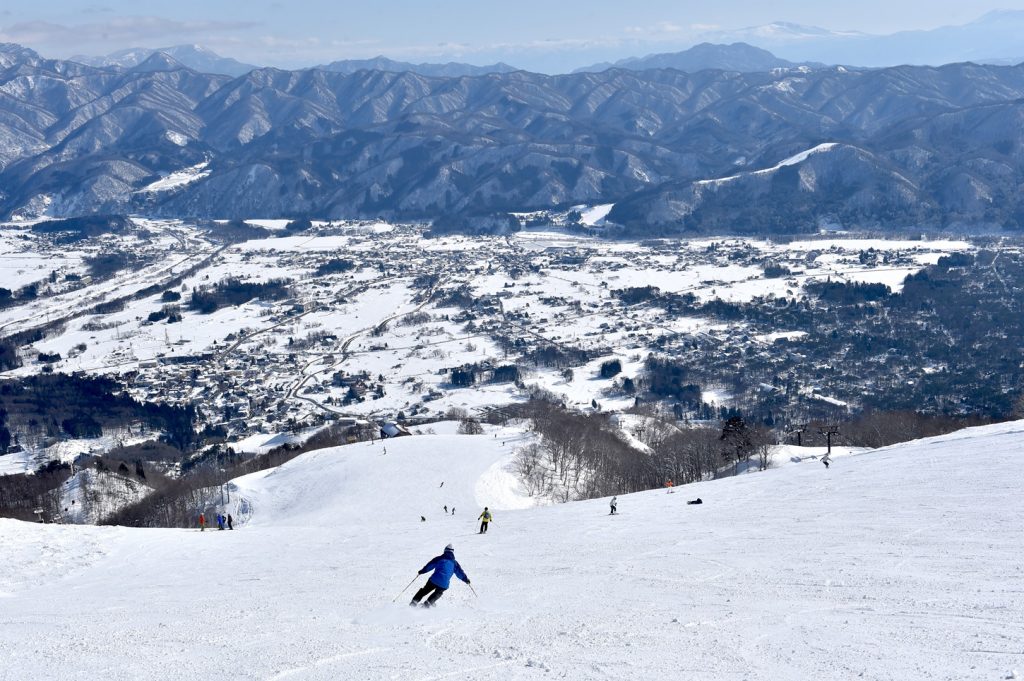
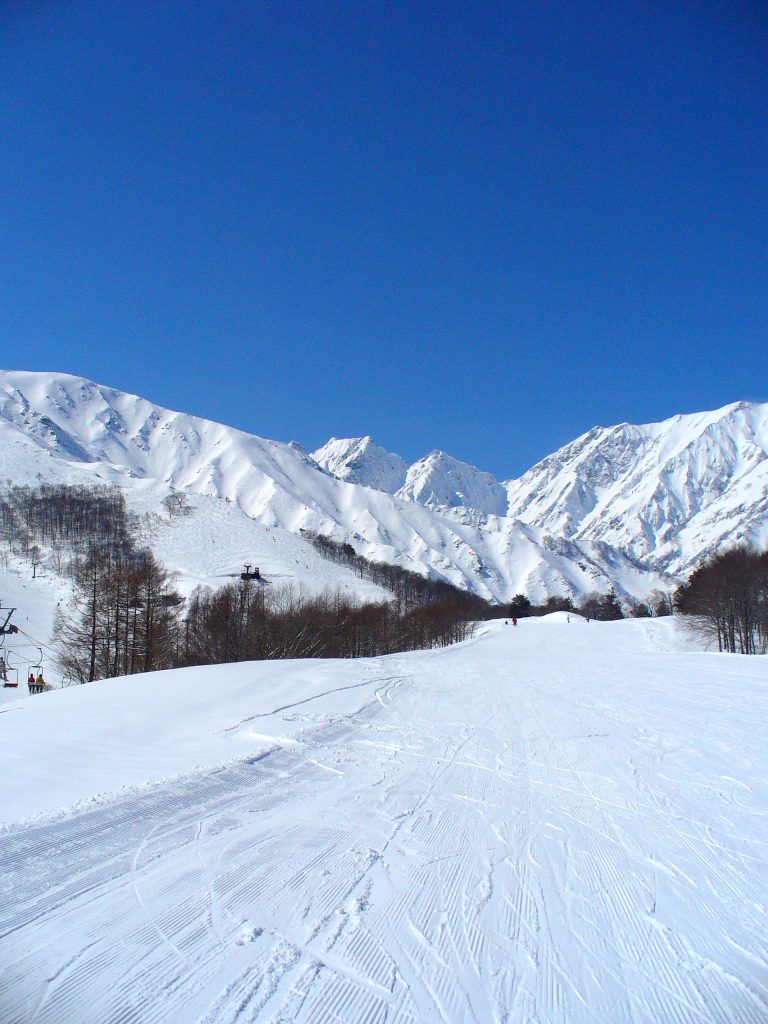
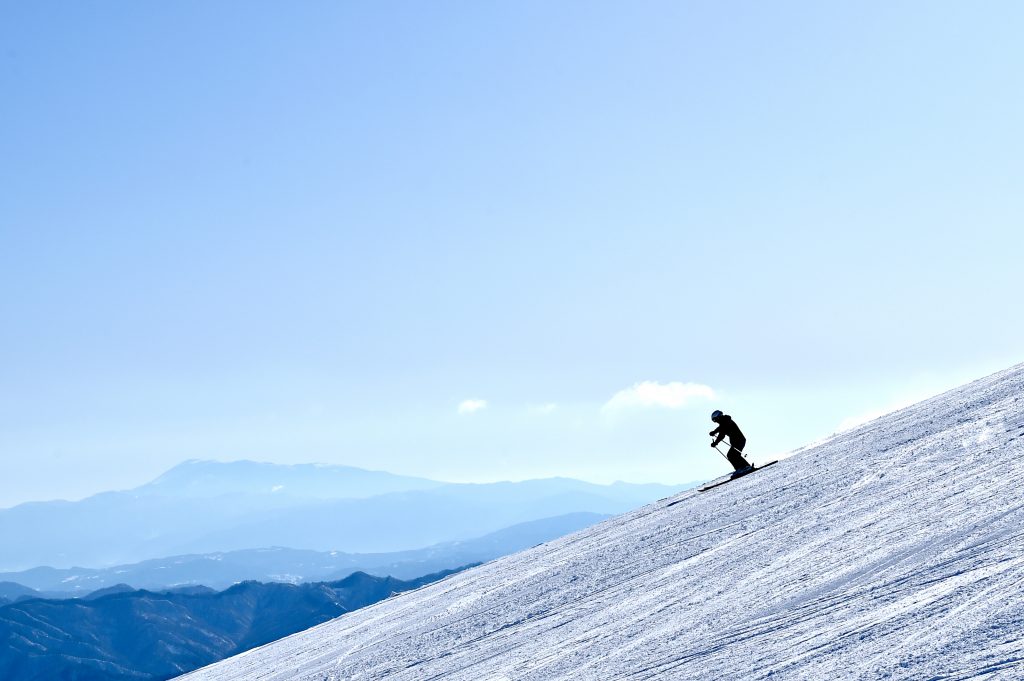
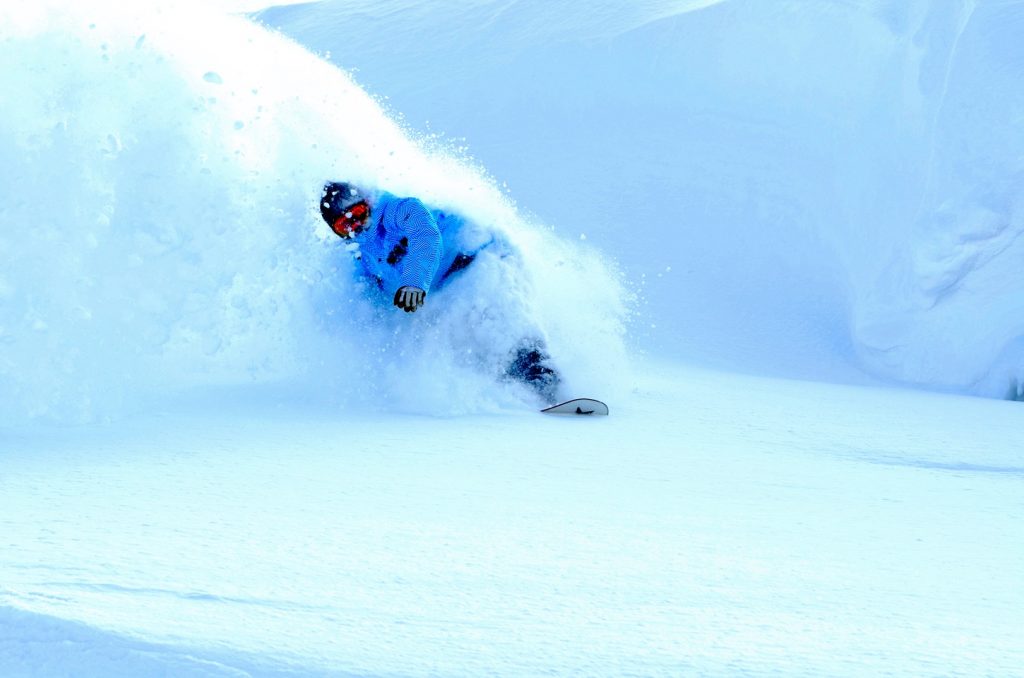
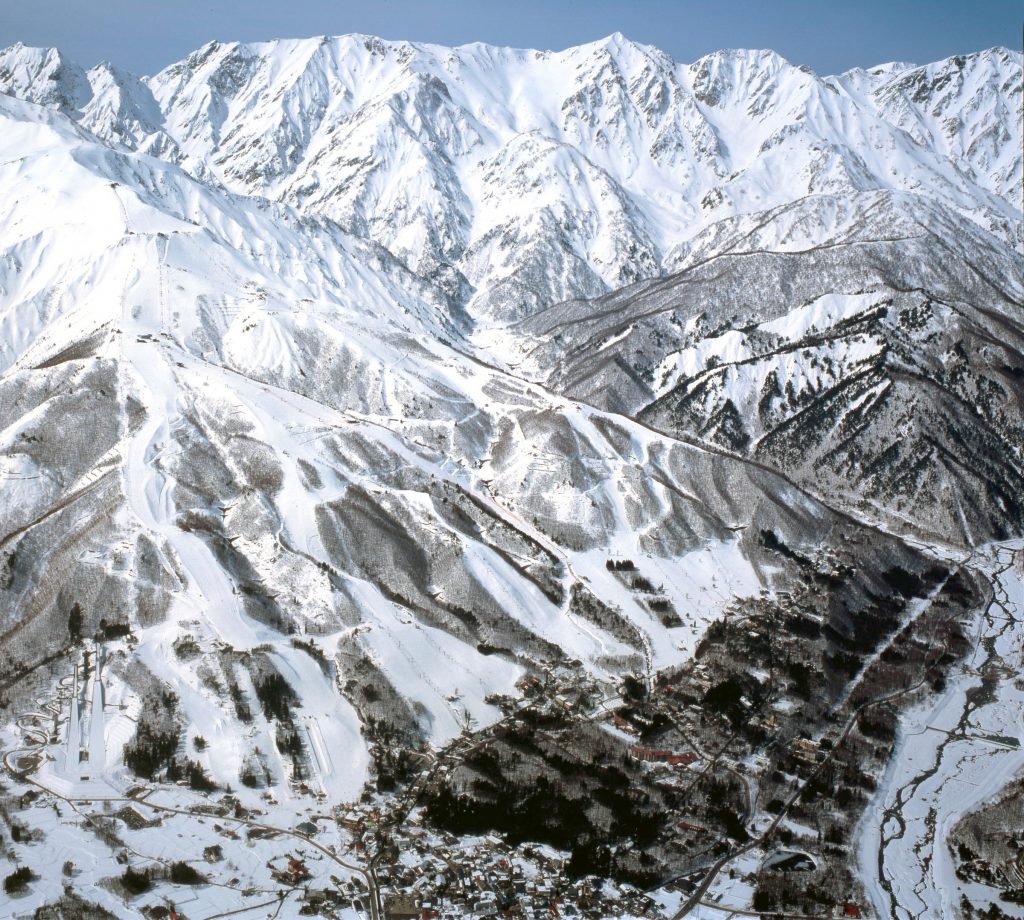
Riesenslalom Course
Hakuba Happo-one’s renowned Riesenslalom (Giant Slalom) course boasts over 70 years of history and is the site for the area’s popular skiing competition known by the same name. The development of the Riesenslalom course dates back to the year 1945. The founder Fukuoka Takayuki (1913–1981), a skiing enthusiast and a former professor of German and the theory of physical education at Hosei University, followed his vision of establishing a Japanese long downhill and slalom ski run, similar to the ones in Austria.
Fukuoka was a successful member of his school’s track and field club, and began practicing skiing and mountain climbing as a form of athletics training. The cold weather won over his heart though, and he soon turned his full attention to winter sports.
Fukuoka studied different skiing techniques and methods, and eventually published his own book based on his experiences. After resettling to Hosono (modern-day Hakuba Happo-one) shortly before World War II (1939–1945), he found an appropriate place to develop a run for downhill and slalom skiing. After convincing the local government to develop the run by emphasizing the potential of skiing to draw tourists to the area, the construction work for the Riesenslalom was completed in 1946, and the first Happo-one Riesenslalom Competition was held in 1947. With no ski-lifts or ropeways, early skiers of the Riesenslalom course had to demonstrate excellent mountain climbing skills to reach the top of the 4,500 m–long run, with an elevation difference of 1,030 m, before enjoying the run. This demonstrates how deeply connected skiing and mountain climbing were during the early days of skiing in Japan. It took another seven years until the first lift—the Nakiyama lift—was ready for operation, connecting the foot of the mountain with the Riesenslalom Course.
Since the first Happo-one Riesenslalom Competition in 1947, amateur participants who reach the line within a few seconds difference from the top skiers are rewarded with an oval-shaped badge, which is black, blue, or red depending on how close they got to the leaders. The year 2019 marks the 73rd anniversary of the competition, which continues to be one of the area’s most-loved annual events and attended by both locals and international skiers.
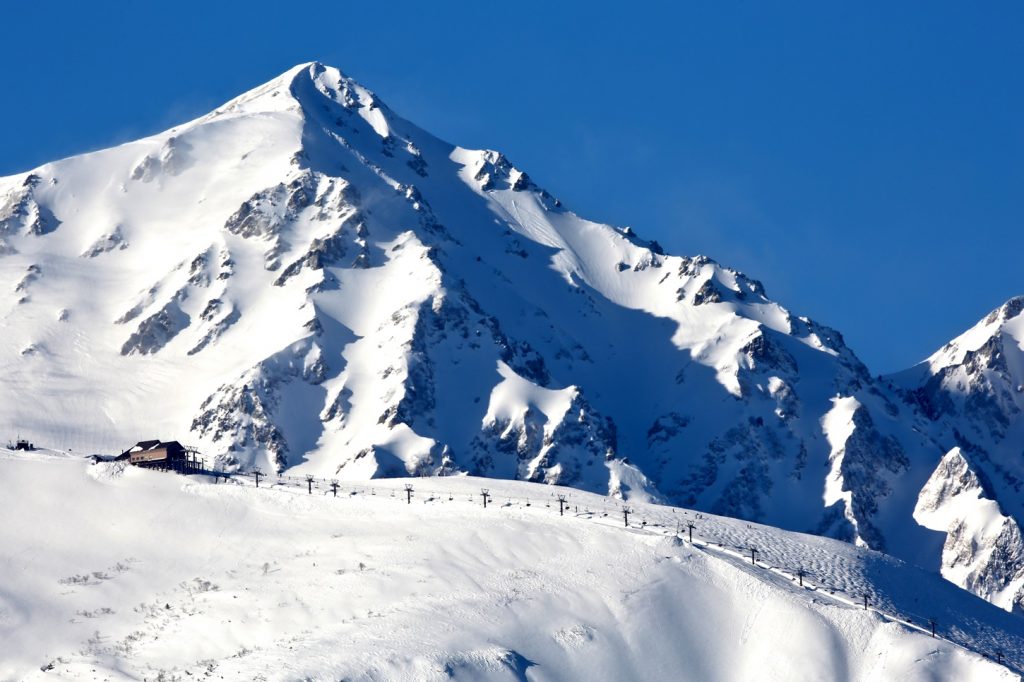
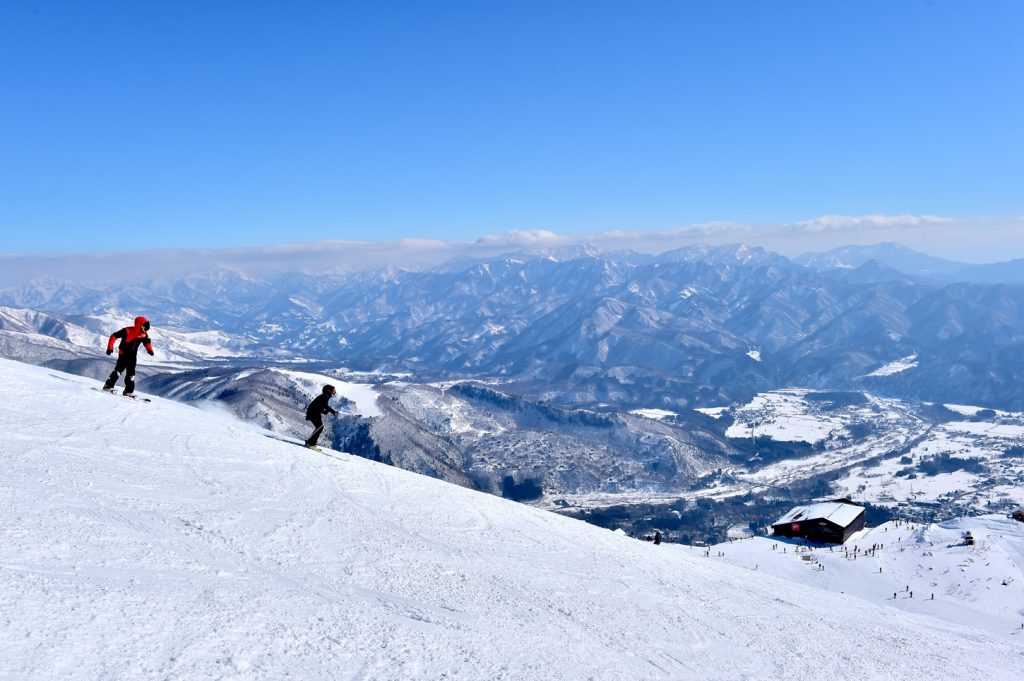
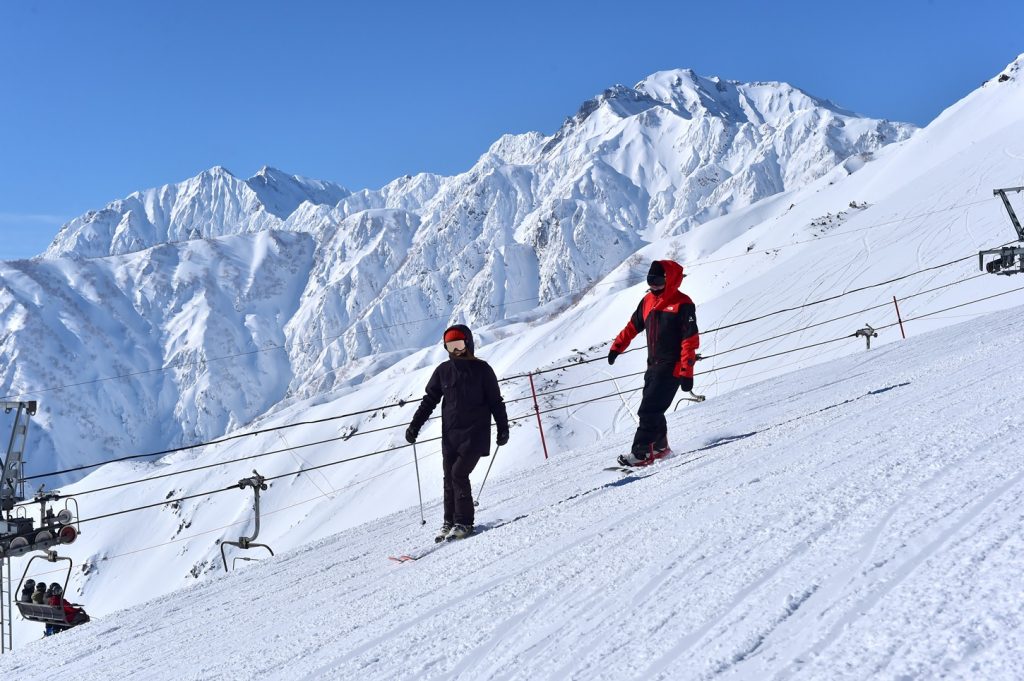
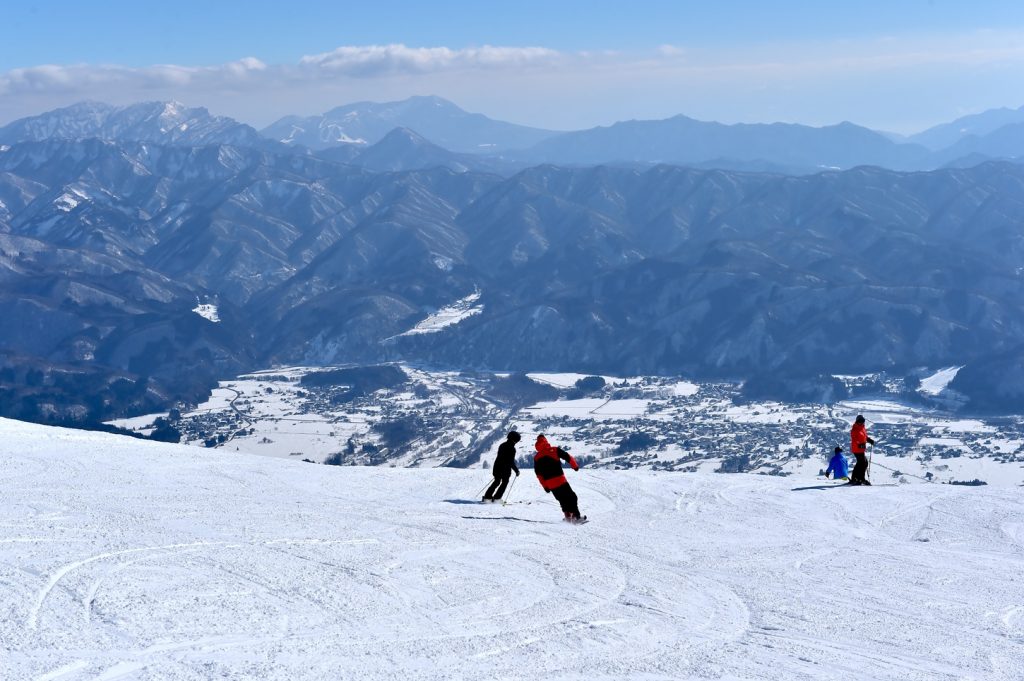
Urakuro
In the Urakuro on the northern slope of the Kurobishi 3 lift in the Happo One ski area, you can slide with the superb powder snow against the dynamic mountains of the North Alps.
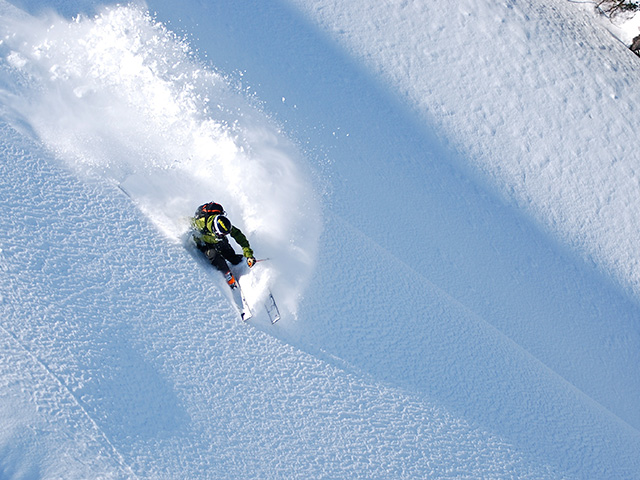
Corona Escape Terrace
“Corona Escape Terrace” overlooking the beautiful moun- tains of the Northern Alps such as Togakushi mountain range, Asama mountain, Utsukushigahara and the Yatsuga- take mountain range is a terrace lounge facing the “superb view” that appeared in the middle of nature. Let’s chill out with the corona with friends, lovers, friends, while enjoying skiing and snowboarding.
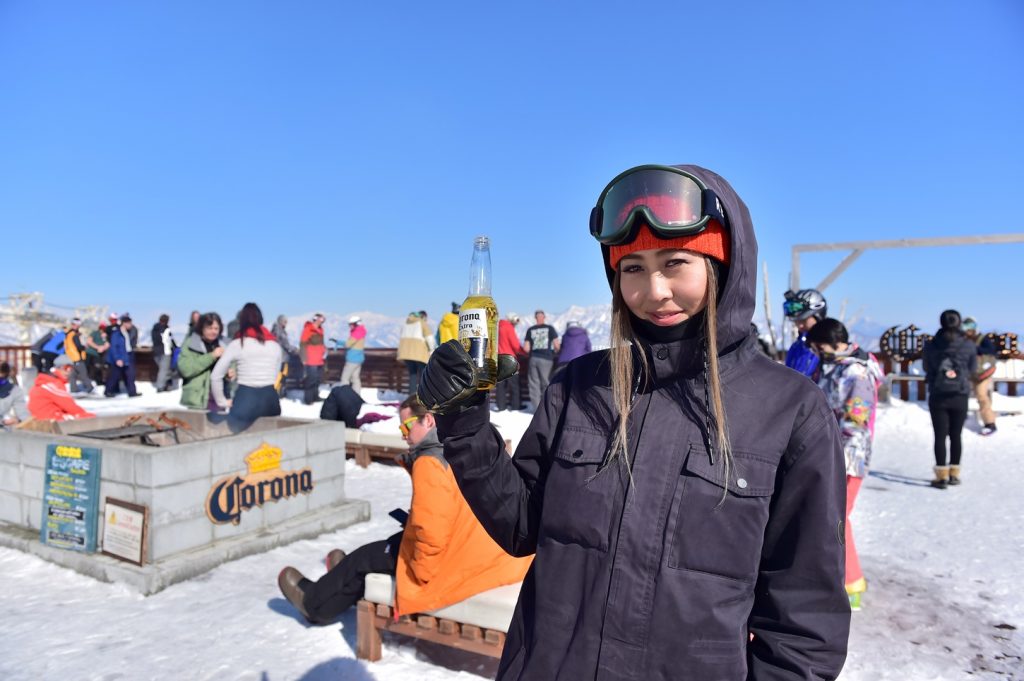
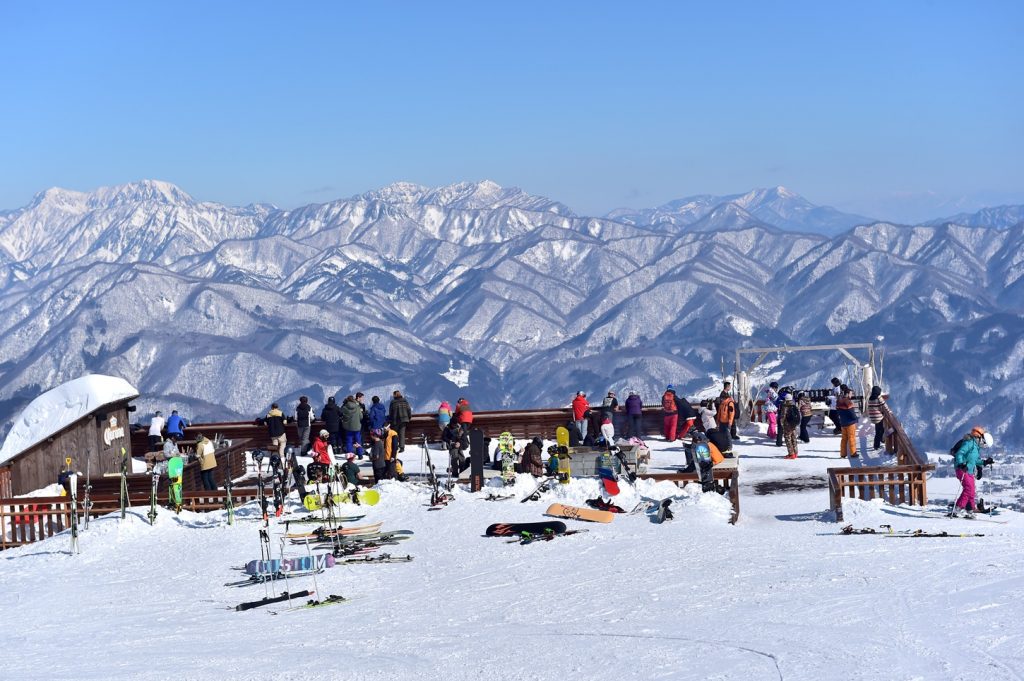
Ski & Snowboard School
Happo One Ski School has excellent instructor skiing and snowboarding lessons boasting more than 80 years history and has created top skiers. Snowshoes, cross country skiing, telemark skiing, etc. Major nature and enjoying lessons and tours are also held.
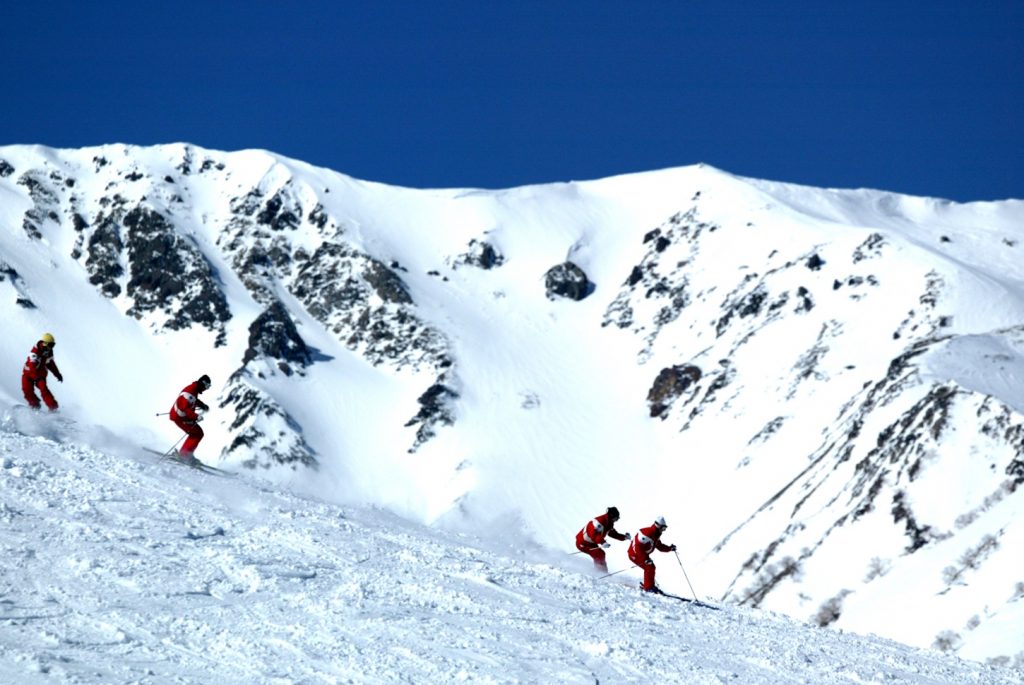

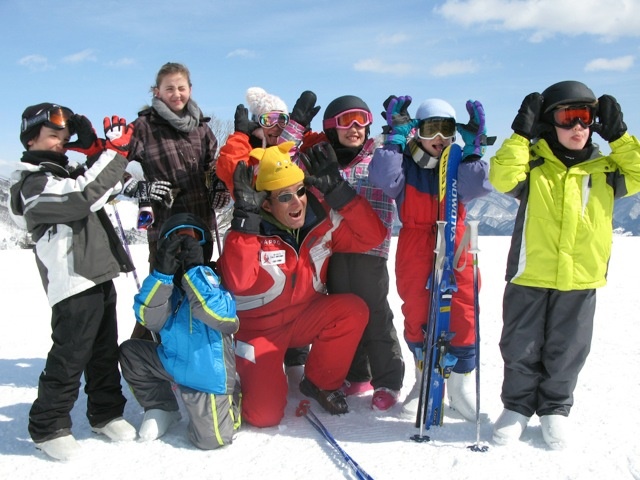
Hakuba Ski Jumping Stadium
Completed in November 1992, this colossal structure capable of accommodating 45,000 spec- tators hosted the ski jumping events during the 1998 Nagano Winter Olympics. Athletes from all over the world competed on two differently sized ski jumping slopes the Normal Hill (318m) and the Large Hill (385 m) resulting in two gold medals for the Japanese Olympic team. Nowadays, the Hakuba Ski Jumping Stadium, which is located directly at the foot of Japan’s Northern Alps, counts as one of Hakuba Happo-one’s most popular sightseeing spots and is open year-round. Curious visitors can hop on the lift that runs between the two hills and get off at the tower, which provides access to the in-runs. While taking the elevator upwards, you may wonder why it’s much taller than your average lift, but the additional space is necessary to accommodate long skis. From the observation deck you can enjoy marvelous views of the surrounding area, as well as imagining the thrilling anticipation of the athletes shortly before they jump off.The floors of the connecting passageways between tower and jumping hills were built with gratings, making it possible to admire the scenery below as well.
Occasionally the stadium is still used by ski jumping professionals for training purposes. Thanks to a slippery artificial surface, it is even possible to practice in the summer.
After exploring the ski jumping hills, venture out to the plateau on the opposite side and gaze at the Olympic cauldron. The Olympic fire was clearly visible from the top of the jumping hills to encourage the athletes.
The monument next to it was added after the 1998 Nagano Winter Olympics to celebrate and commemorate the 100th gold medal that was achieved by Japanese athletes at this competition.
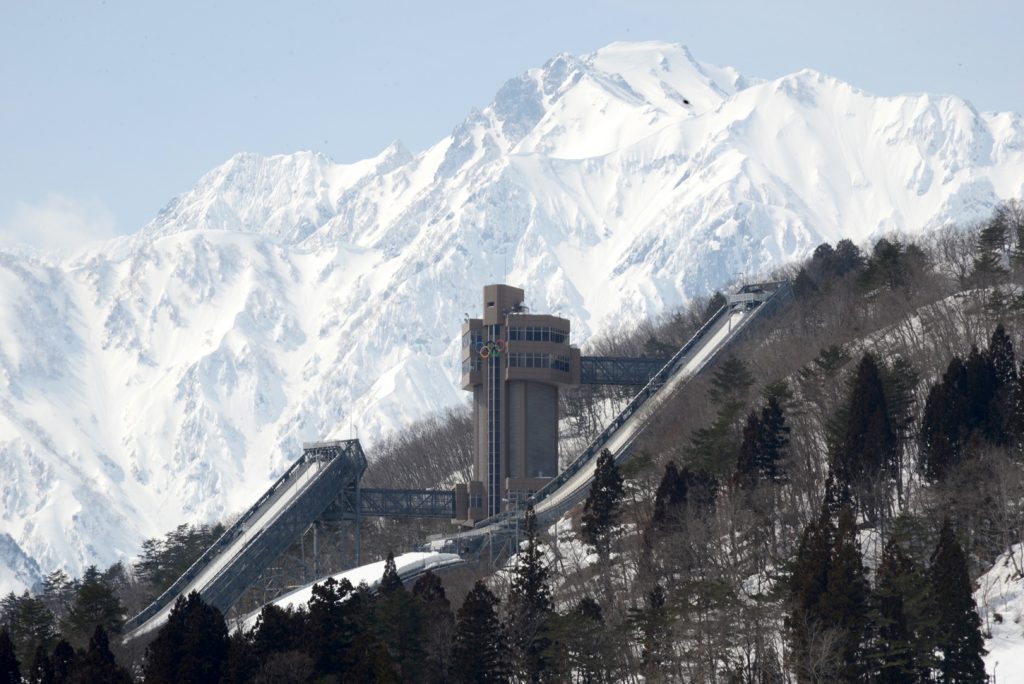

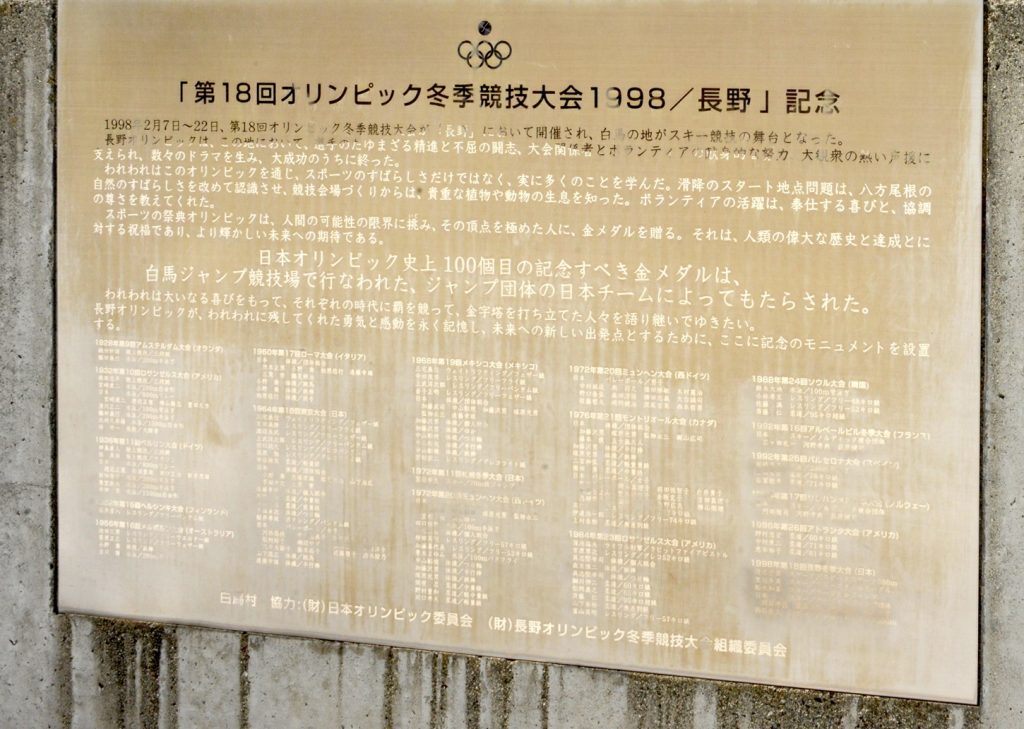
Hakuba VAlley
Japan’s Largest Snow Resort
The general west-to-east flow of weather pushes cold air from Eurasia over the Sea of Japan and then into the mountains along the west coast of Japan. The combination of cold air, moisture from the Sea of Japan, and the ascending air created when the wind hits the Japan Alps is bringing an average snowfall of more than 13 meters.
Hakuba Valley is located in the northwestern part of Nagano Prefecture only 2.5 hours from central Tokyo, which has been blessed with fertile land, mountains and historical heritage. After hosting the Winter Olympics back in 1998, this large resort with 30 kilometers north to south and 10 independent ski resorts has been attracting attention with stunning beauty of the Japan Alps, high-quality snow and a diversity of terrain.
More than 100 years since the beginning of ski culture in this small rural village, Hakuba Valley now offers 143 courses, 941 hectares of skiable areas, and a 134,554m lift-accessible terrain which is well suited for all ability levels of skiers/riders and all those who are seeking for a brilliant powder experience.
The resort provides many lodging options to fit any budget, suit any group, and deliver on anyone’s idea of what the perfect vacation is all about.
If you want to make your trip even more unforgettable, take a day off and explore culturally and historically our rich neighboring cities Nagano and Matsumoto. “Zenkoji Temple” and “Matsumoto Castle” are inspiring on any kind of day, sunny or cloudy day’s or even during gentle snow falls.
Fantastic ski regions with superb pistes and magnificent deep powder snow make Hakuba Valley the home of winter sports.
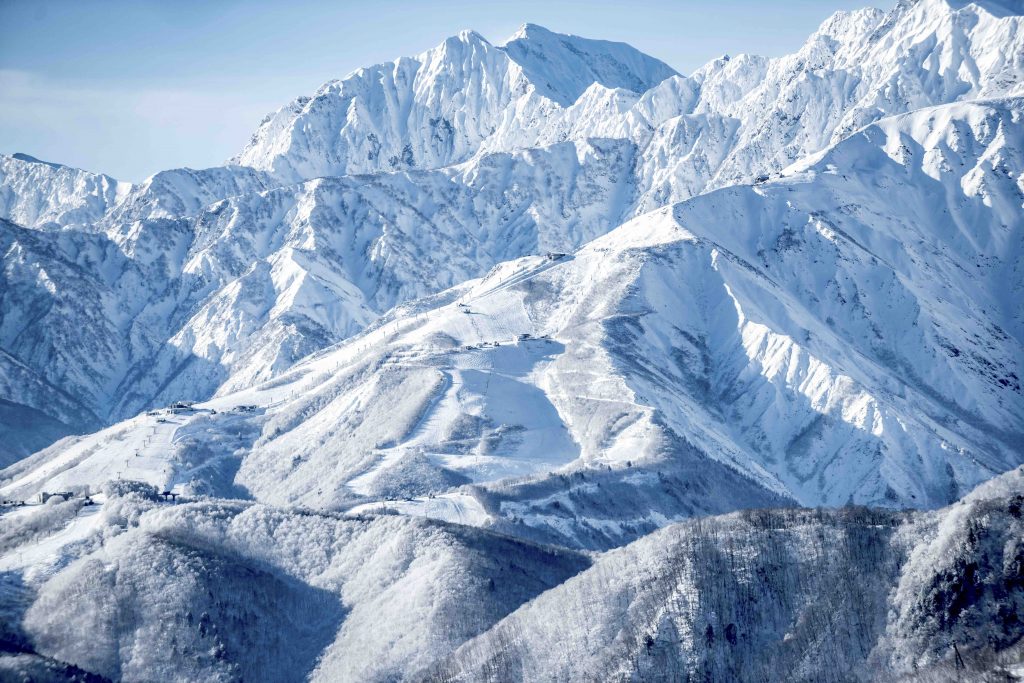

Epic Pass
Hakuba Valley joined the Epic Pass, Epic Local Pass and Epic Australia Pass in a long-term alliance at the beginning of the 2018-19 winter season. Epic Pass holders will receive five consecutive complimentary days with no blackout dates at Hakuba Valley’s 10 ski resorts.



Accommodation
Hakuba Valley is the place to visit any time of year. From luxury hotels, bed and breakfasts to condominiums and budget pensions, Japanese “Ryokan” with traditional archi- tecture, there is a place for you to relax and experience all that Hakuba Valley has to offer.
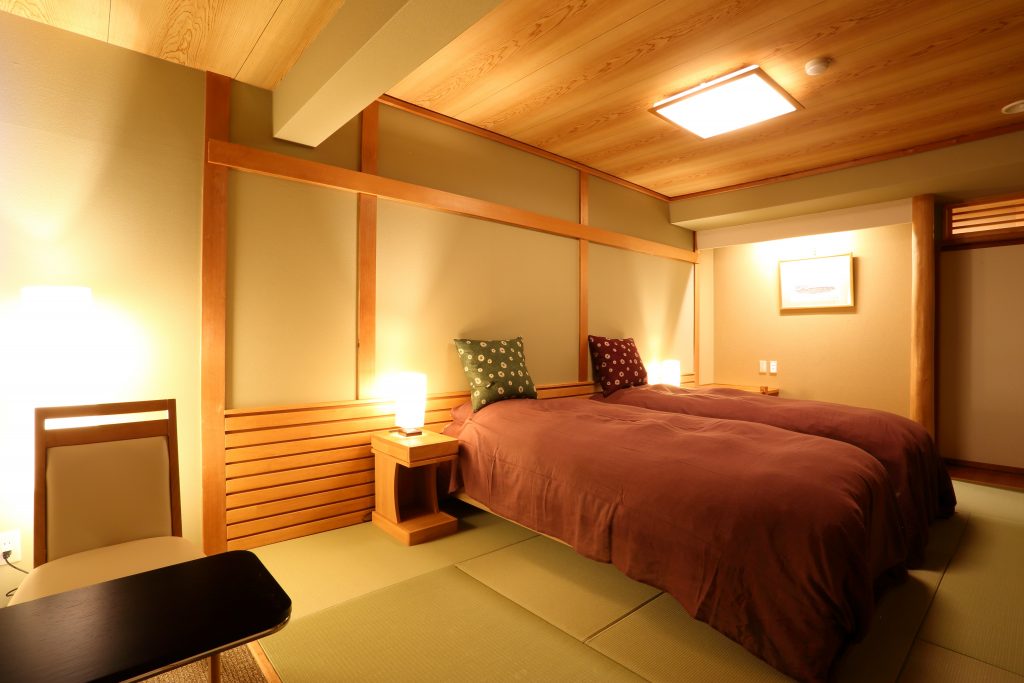
Winter Glamping
Most people assume that glamping is only suitable during the summer months. In Hakuba Valley the luxury camping season is the whole year round! Even during the winter it’s possible to enjoy a relaxing apres and gorgeous dinner in a luxury glamping tent!
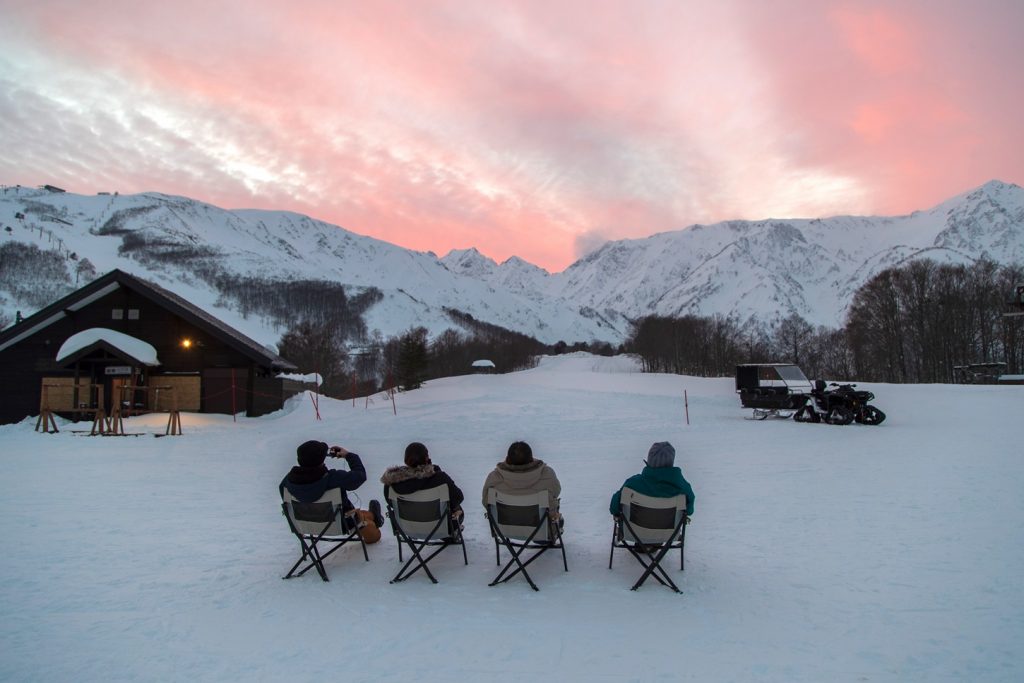
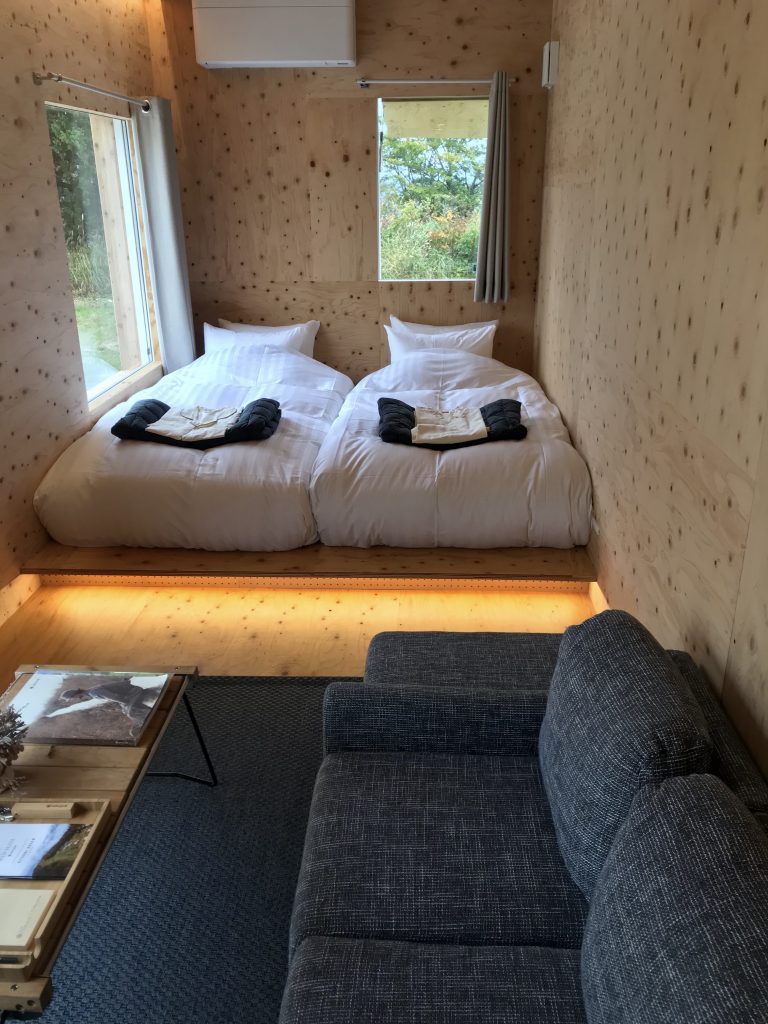
Food
From gourmet menus to traditional Japanese meals, casual on mountain convenience dishes and of course to vege- tarian/vegan options. There’s something fresh and deli- cious to please every type of palate. Our topnotch cuisine in Hakuba Valley attracts food-lovers far and wide.
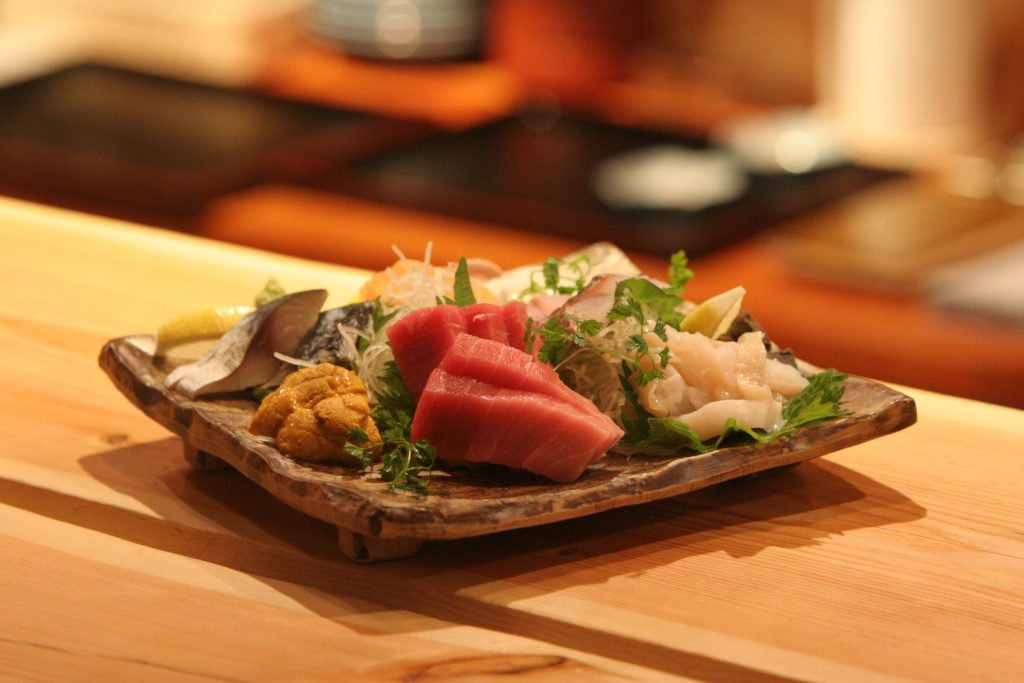
Green Season
Not only for the winter season, but for the green season, the city is crowded with climbers aiming for the majestic Hakuba Commonwealth. Along with the flow of the seasons, Happo one changes scenery variously and continues to attract visitors.

Hakuba Happo-one’s Hot Spring
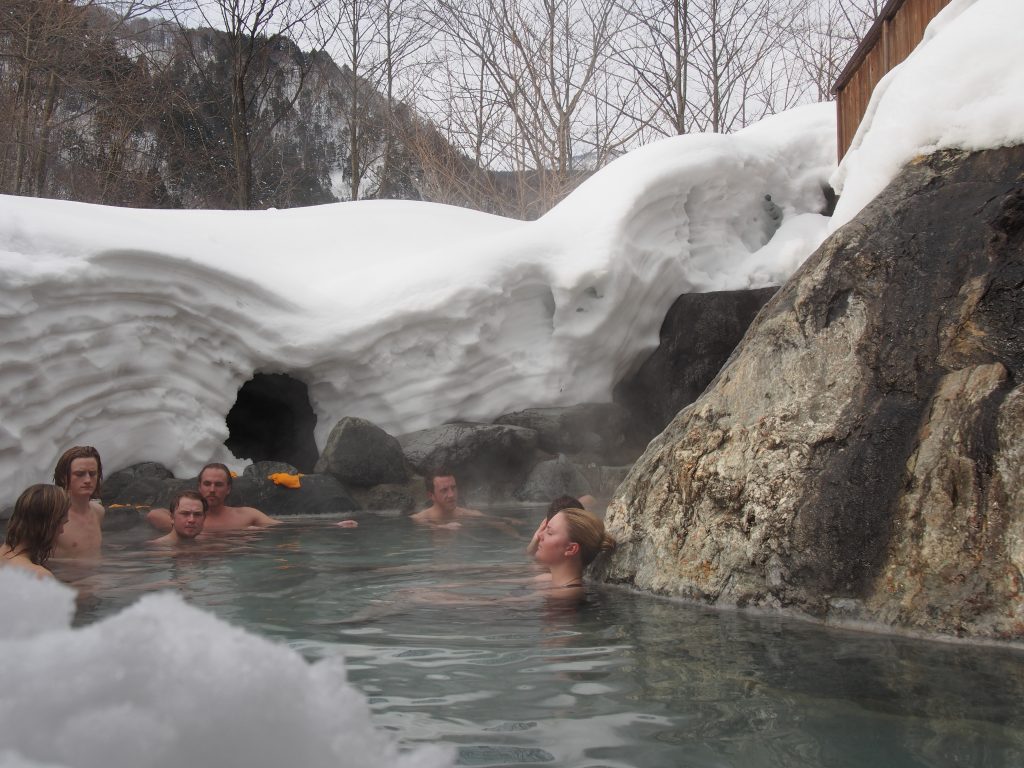
Hakuba Happo-one’s onsen (hot spring) is an alkaline hot spring flowing from the serpentinite layers near the peak of Mt. Yari, one of the three Shirouma Sanzan mountains. Its colorless, clear hot water has a pH of over 11, making it one of the strongest alkaline hot springs in Japan. Its water removes excessive keratin to stimulate the revitalization of the skin, leaving it soft and smooth.
Research conducted by the Earth-Life Science Institute of the Tokyo Institute of Technology has revealed that due to the water’s high temperature, the number of bacteria in Hakuba Happo-one’s hot spring is much lower than at other onsen. Furthermore, Hakuba’s hot spring water reacts with peri- dotite, the type of rock comprising the Earth’s deep mantle, and forms hydrocarbons, the basis of life. When peridotite is exposed to the seafloor or the Earth’s surface as a result of tectonic movement and reacts with the water, it turns into serpentinite.
History of Hakuba Happo-one’s Hot Spring
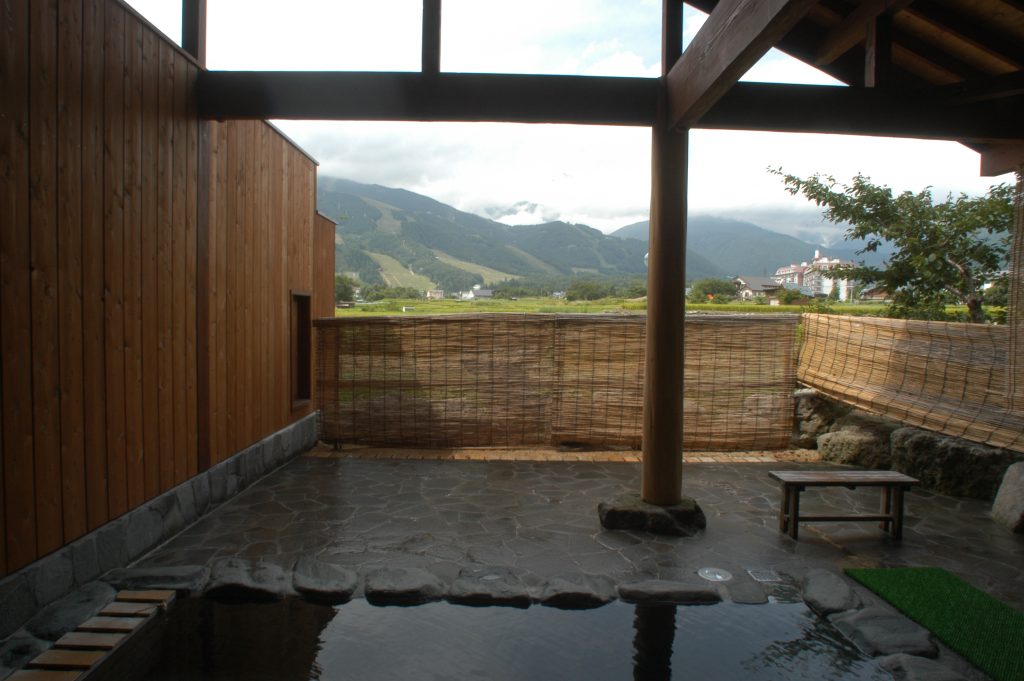
Since the area was first settled, the residents of Hakuba Happo-one have dreamt of drawing water from the source of an onsen (hot spring) high up in the mountains down to the village. After a number of failed attempts, it seemed that this dream would turn to reality at the end of the 19th century, but the construction works were overshadowed by a tragic accident.
In the spring of 1875, 60 people started to realize a project to draw down water from the source of the hot spring located at 2,100 m of Mt. Yari. After 2 km of bamboo pipes were already laid, a massive avalanche hit the construction site in November of the same year. Since 21 people lost their lives, the project was put on hold for over a century.
About five decades later, Matsuzawa Teiitsu (1889–1926), a well-respected mountaineer and the founder of the tourist association of Hakuba, established a mountain hut with an adjoining open-air bath near the source of the hot spring Hakuba Yari Onsen. Since then, it has become known as one of the highest outdoor hot spring resorts in Japan and a popular destination for both mountaineers and onsen lovers.
It took another 60 years until a new plan was created to draw water from the hot spring’s source. Finally in 1983, the excavation of the source on the south side directly under Hakuba Yari Onsen succeeded. A few years later all the pipes were laid and the concept of turning Hakuba Happo-one into an onsen resort took form. The project transformed the town with dozens of lodging facilities, including hotels, ryokan (Japanese-style inn) and minshuku (Japanese-style guest houses run by families), as well as four public hot spring facilities, which were connected to the hot spring opening. Eventually the century-long wish of the locals was granted.
Now, the little onsen town is popular for the anti-aging effects of its beautifying baths. Due to the strong alkaline hot water with a pH of over 11, bathers find that their skin becomes very smooth and soft. And even more, bathers also claim that the additional health benefits of the onsen water supports the healing process of muscular pain, nerve damage, and more. If you’re not comfortable entering an onsen, where you’ll usually be expected to bathe naked, you can enjoy the hot water at one of the free foot baths sprinkled across the village.
Since the area was first settled, the residents of Hakuba Happo-one have dreamt of drawing water from the source of an onsen (hot spring) high up in the mountains down to the village. After a number of failed attempts, it seemed that this dream would turn to reality at the end of the 19th century, but the construction works were overshadowed by a tragic accident.
In the spring of 1875, 60 people started to realize a project to draw down water from the source of the hot spring located at 2,100 m of Mt. Yari. After 2 km of bamboo pipes were already laid, a massive avalanche hit the construction site in November of the same year. Since 21 people lost their lives, the project was put on hold for over a century.
About five decades later, Matsuzawa Teiitsu (1889–1926), a well-respected mountaineer and the founder of the tourist association of Hakuba, established a mountain hut with an adjoining open-air bath near the source of the hot spring Hakuba Yari Onsen. Since then, it has become known as one of the highest outdoor hot spring resorts in Japan and a popular destination for both mountaineers and onsen lovers.
It took another 60 years until a new plan was created to draw water from the hot spring’s source. Finally in 1983, the excavation of the source on the south side directly under Hakuba Yari Onsen succeeded. A few years later all the pipes were laid and the concept of turning Hakuba Happo-one into an onsen resort took form. The project transformed the town with dozens of lodging facilities, including hotels, ryokan (Japanese-style inn) and minshuku (Japanese-style guest houses run by families), as well as four public hot spring facilities, which were connected to the hot spring opening. Eventually the century-long wish of the locals was granted.
Now, the little onsen town is popular for the anti-aging effects of its beautifying baths. Due to the strong alkaline hot water with a pH of over 11, bathers find that their skin becomes very smooth and soft. And even more, bathers also claim that the additional health benefits of the onsen water supports the healing process of muscular pain, nerve damage, and more. If you’re not comfortable entering an onsen, where you’ll usually be expected to bathe naked, you can enjoy the hot water at one of the free foot baths sprinkled across the village.
Naturally Hydrogenated Hot Water
The water temperatures and the properties at Hakuba Happo-one are thought to be very similar to those of the primordial Earth before the appearance of life, making it an essential place for scientists to examine the origins of life. Here you can also enjoy health-promoting waters from the beginning of time.
*You will experience peak hydrogen concentration five minutes after entering the bath: the ppb (parts per billion) you will encounter is 50–60, although at the hot spring’s tap that rises to an amazing 120 ppb.
Obitana no Yu

This little outdoor hot spring facility is located about 3 km away from the center of Hakuba Happo-one and is the closest one to the source. The baths are basic, but surrounded by abundant nature, making them an ideal place to fully unwind. The large serpentinite rock, which divides the two bathing areas, adds to the natural atmosphere. Should rain or snow fall, Obinata no Yu will provide traditional bamboo hats for cover, making it a special experience year-round.
The best time to enjoy this little oasis is during the winter, when visitors can book the entire snow-surrounded baths for private evening dips. Normally onsen (hot spring) facilities have different areas for each sex, as bathers are expected to be naked, but swimwear is allowed during these special sessions, meaning you are able to enjoy the cozy bath together with your friends, family, or partner.
The facility’s natural hydrogen water is said to have anti-aging effects through antioxidant actions. You can even take a sip of the water at the little tasting corner next to the entrance. Nevertheless, you should dilute the onsen water with normal tap water before drinking it, as the alkalinity pH value is around 11.
*The hydrogen concentration at Obinata no Yu’s hot spring tap rises to 250 ppb (parts per billion).
Japanese Hot Springs: Manners and Rules
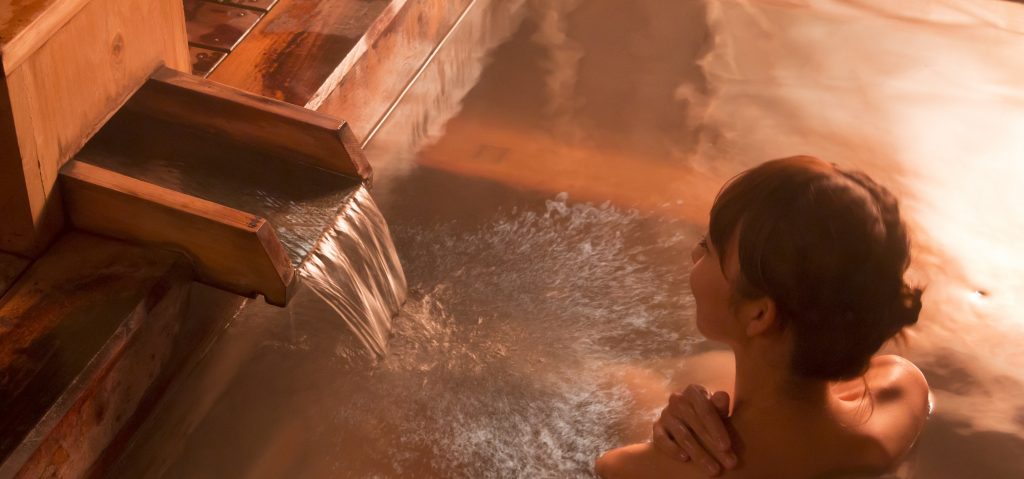
Visiting a hot spring, or onsen in Japanese, is the highlight of many people’s visit to Hakuba Happo-one, but keep in mind that there are several rules to follow. The first thing foreign travelers may be surprised about is the strict prohibition of people with tattoos entering the water. If your tattoo is small enough to be covered up, you can bring skin-colored, waterproof stickers, but otherwise you won’t be permitted entry.
Upon entering the onsen facility, you should take off your shoes before stepping into the changing and bathing area. Before entering the bath, wash yourself thoroughly using the facilities provided. The washing area is usually located inside the bathing area. Please remember that swimwear is not allowed in hot spring facilities.
Avoid jumping into the water, since the tub is not deep enough and it may disturb other visitors. Keep in mind that your towel shouldn’t touch the bathing water, or be wrung out into it—it’s seen as dirtying the water. Instead, place it on your head or the side of the bath. This is an area for quiet soaking and contemplation, not swimming or splashing about. After you’ve enjoyed the hot spring water, dry your body carefully before heading back to the changing room, otherwise the floor may get slippery.
It’s absolutely prohibited to take photos inside the bathing area, and also please refrain from bringing any alcoholic beverages into the bath. Observe these simple rules and you are in for a rejuvenating soak like no other.
Trek Through the Chubu-Sangaku National Park
During the green season, usually between June and October, Hakuba Happo-one’s most popular and picturesque trekking route takes hikers through the Chubu Sangaku National Park. Start your journey at the Happo Ike Sanso Station, the final stop of the Happo Alpenline and the Kurobishi line. On a clear day, you will be able to gaze out over 100 of Japan’s most picturesque mountains, including the iconic Mt. Fuji.
The hike leads you through lush green highlands, with plenty of endemic alpine plants, which have been designated Natural Monuments of Nagano Prefecture. With a little bit of luck, you can even watch Japanese serows and snow grouses in their natural surroundings.
After an ascent of around 90 minutes, you’ll come to the crystal-clear Happo Pond, also known as the observation platform of Japan’s Northern Alps. At an altitude of 2,060 m, you’ll be wowed by breathtaking views of the Shirouma Sanzan mountain range and the sky, reflecting in the pond’s deep blue water. Take a break at one of the big rocks around the pond and enjoy the fresh summer breeze high up in the mountains.
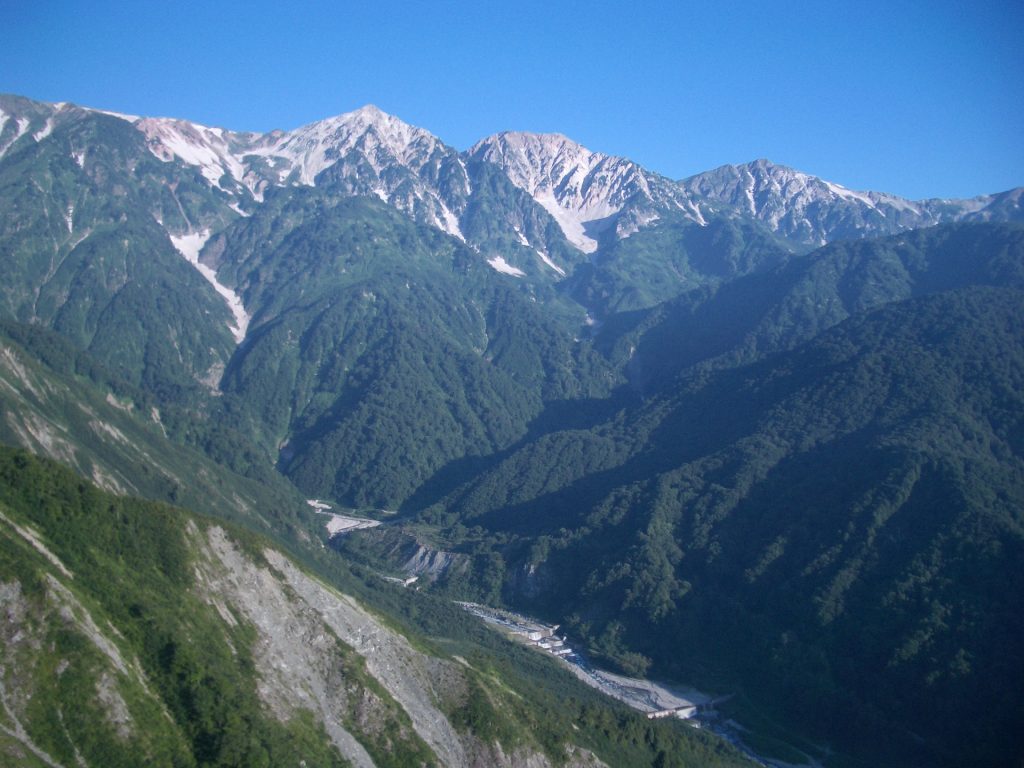
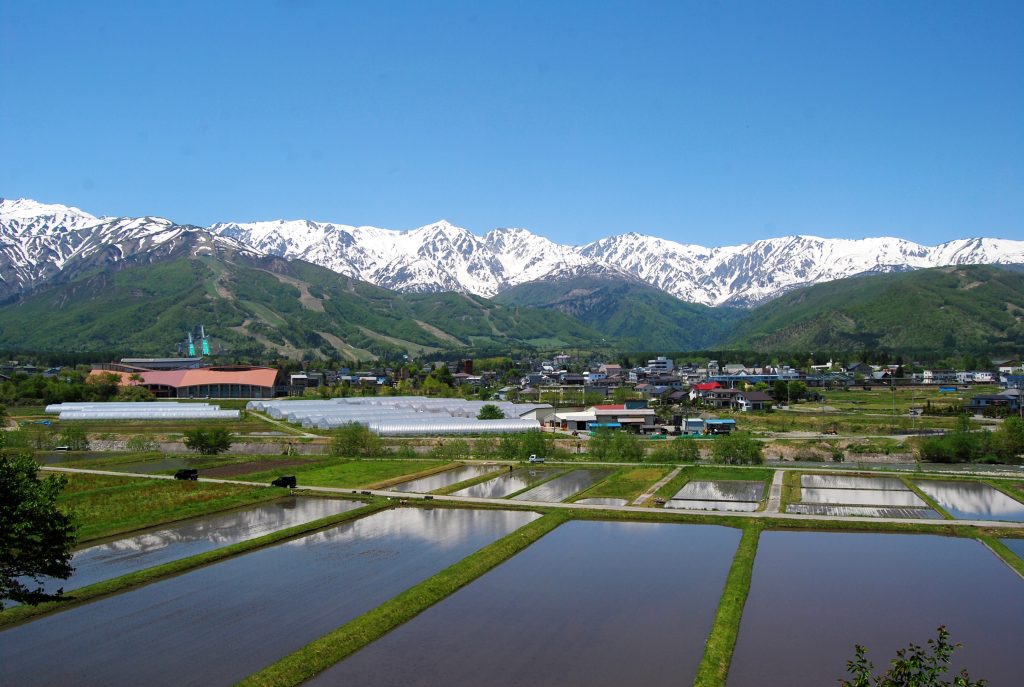
Take a Ride on the Happo Alpenline
The three lifts that make up the Happo Alpenline provide some of the most scenic views of Hakuba Happo-one. Within 30 minutes the Adam gondola lift, the Alpen Quad lift, and the Grad Quad lift bring you to the Happo Ike Sanso Station at an altitude of 1,830 m.
After taking in the awe-inspiring views across Japan’s 100 most famous mountains, venture further north and find yourself surrounded by the lush green highlands, where you can see many endemic alpine plants and animals.
If you are feeling energetic, the Happo Pond is a 90-minute hike from Happo Ike Sanso Station. At an altitude of 2,060 m, the pond is the best spot to take in Japan’s Northern Alps and is a popular sightseeing spot for both Japanese and international visitors. As the mirror-like waters reflect the blue sky and the three peaks of the Shirouma Sanzan mountain range, you’ll soon understand why.
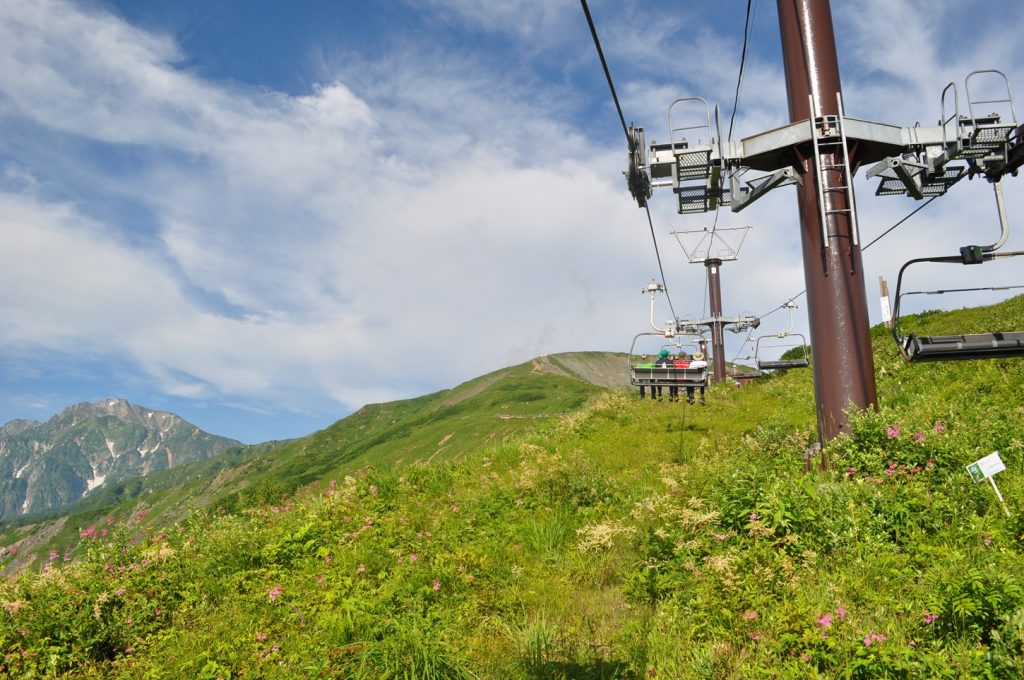
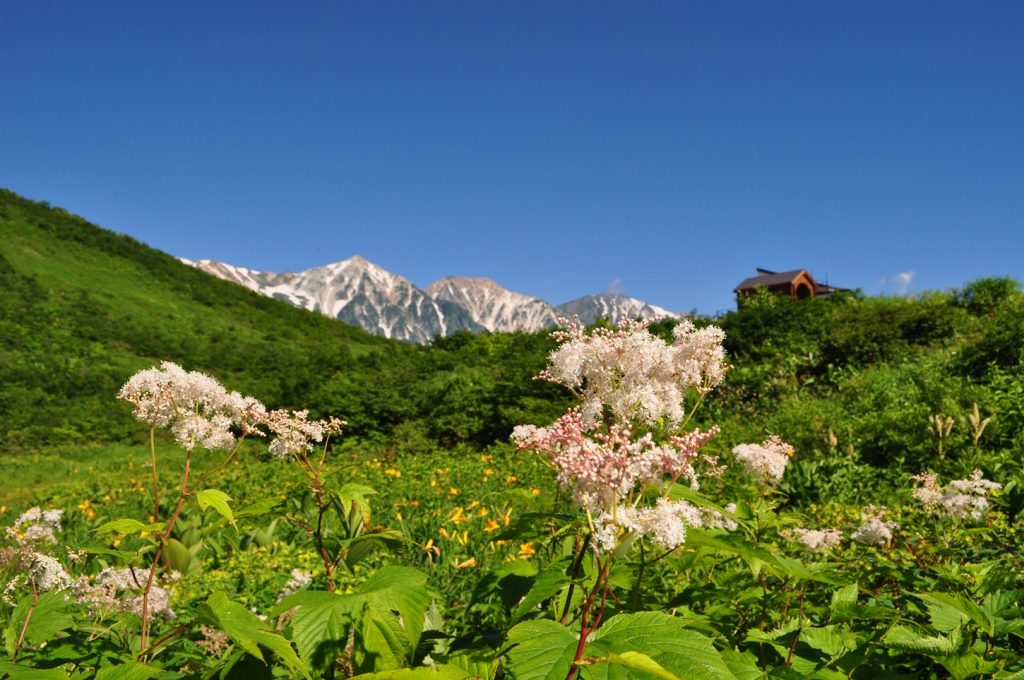
Kurobishi Line
Getting to the Kurobishi Line—a combination of the Kurobishi No. 3 Pair lift (1,500 m) and the Grad Quad lift (1,680 m)—is an adventure in itself. The drive to the station takes you along the picturesque, 8km-long Kurobishi Rindo road, which winds through the lush green forest of Wadano no Mori, taking you past the little Wadano no Mori Church and the Tetsuo Kikuchi Alpine Photograph Gallery. You’ll need to keep your wits about you as the road contains steep curves, sheer drops, and narrow passes, but fortune favors the brave.
After this refreshing drive through the area’s abundant nature, you will eventually reach the Cafeteria Kurobishi, located next to the Kurobishi No. 3 Pair lift. When onboard, the views get even better as you are taken over the amazing scenery of Japan’s Northern Alps.
The Kurobishi No. 3 Pair lift takes you to the Kurobishi plateau and the Kamaike marshland within just a few minutes. You can also venture further by transferring to the Grad Quad lift, from whose final station, Happo Ike Sanso, is the starting point of a popular trekking route to the miraculous mountain pond Happo.
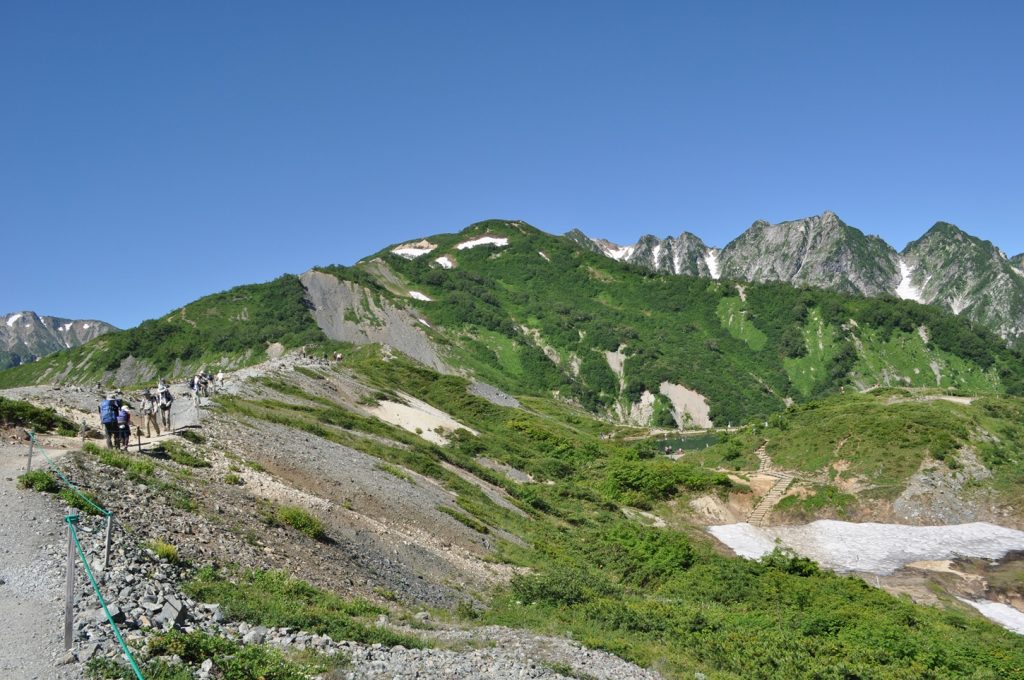
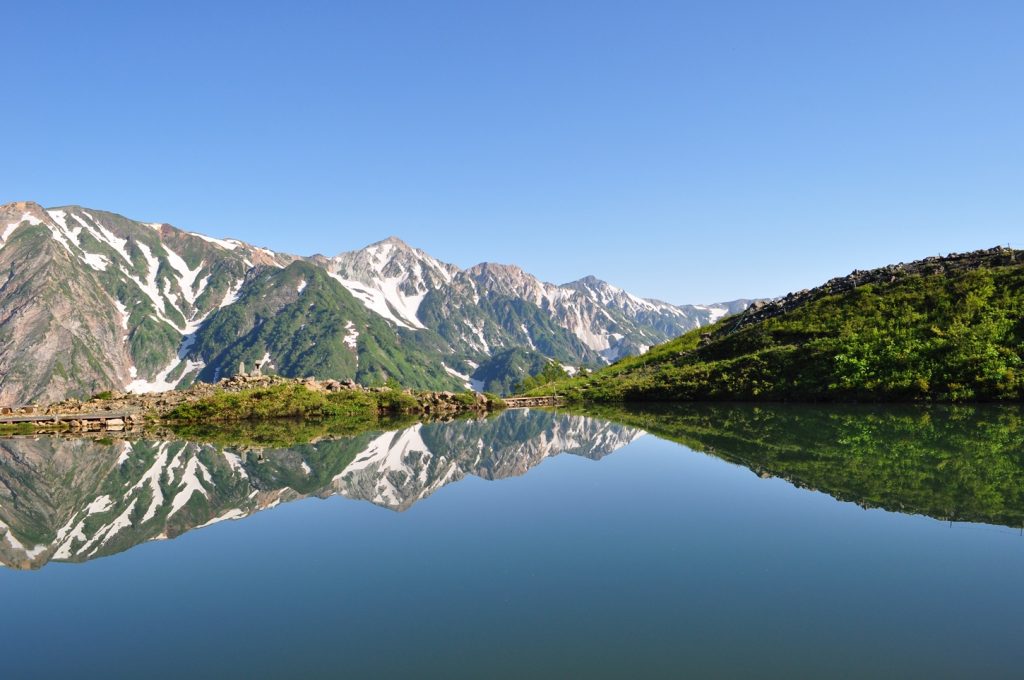
Hakuba Ohashi Bridge
Selected as one of the 100 best roads and streets of Japan, the Hakuba Ohashi Bridge, completed in 1986, is the perfect vantage point from which to marvel at Mt. Shakushi, Mt. Yari, and Mt. Shirouma—three colossal mountains known collectively as Shirouma Sanzan.
Stretching over Matsu River, which flows with crystal-clear meltwater, the bridge has pedestrian walkways on both sides, from where visitors can take in the breathtaking views of this awe-inspiring stretch of Japan’s Northern Alps. The bridge is dotted with informative signs that explain what to look for in the snow formations on top of each mountain throughout the year. For example, one vantage point lets you see the diamond-like shapes formed by falling snow, while another allows you to see the first Japanese character (八) of the area’s name Happo-one etched in the ice.

-680x1024.jpg)
Oide Park
If you want to see how Japan’s traditional rural landscape used to look, this little park offers a window to history. Encompassing an area of 5.9 hectares along both sides of the winding Himekawa River, the park was completed in 2006 and is dedicated to preserving Hakuba Happo-one’s historical scenery.
You can enjoy the area’s abundant nature, while getting to know the locals who inhabit the traditional buildings. The park’s spectacular viewpoint is especially picturesque during cherry blossom season, but capable of taking your breath away at any time of year with its magnificent panorama of the Shirouma Sanzan mountain range of Japan’s Northern Alps, the Himekawa River, the park’s wooden suspension bridge and thatched houses. It is a popular spot for landscape painters, so with luck you can observe a masterpiece in the making.
Snacks and drinks are available at the Tsurihashi Teahouse, or the Kappa Tei Café, which occu- pies a one hundred-year-old structure with a small water wheel near its entrance. Here you can enjoy a range of dishes made from local produce, including pork from Hakuba and Shinshu salmon from Nagano Prefecture. (The Kappa Tei Café operates between May and October).
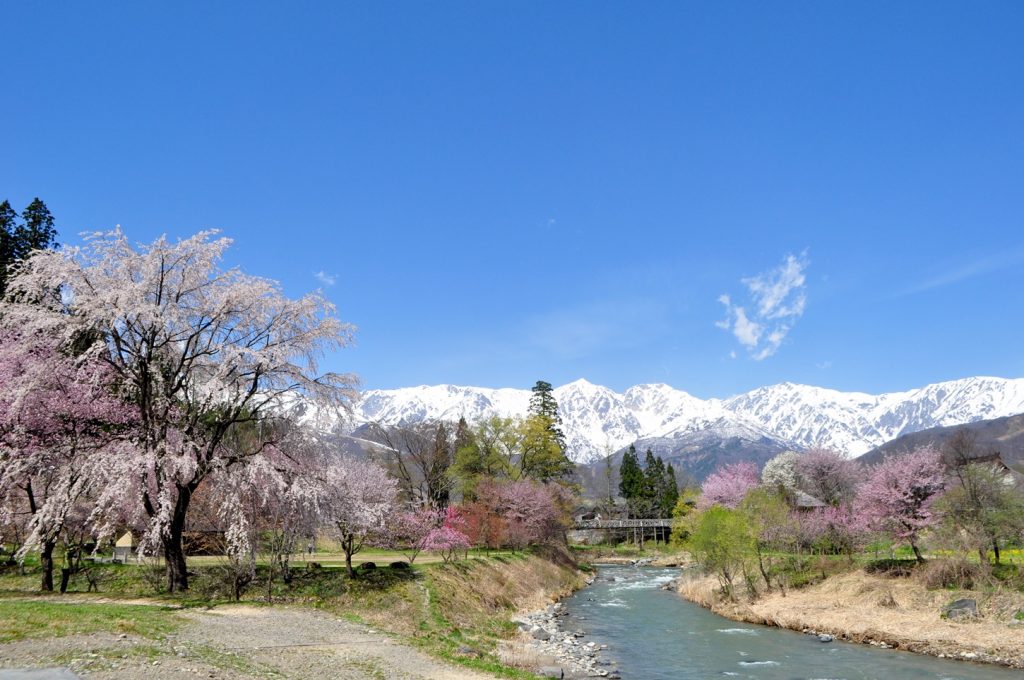
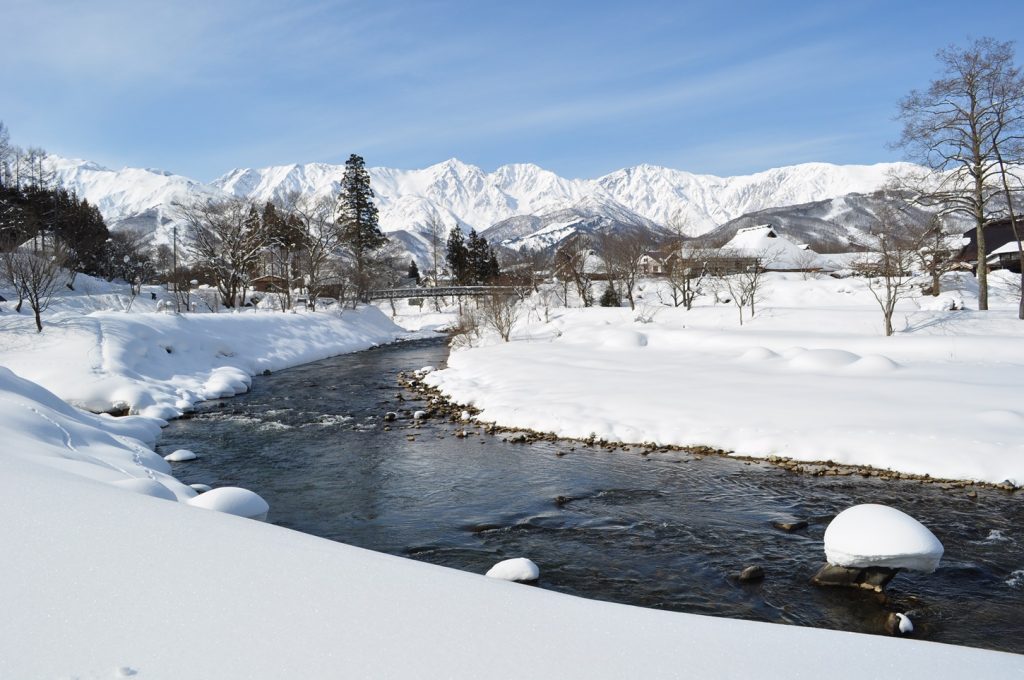
Hosono Suwa Shrine
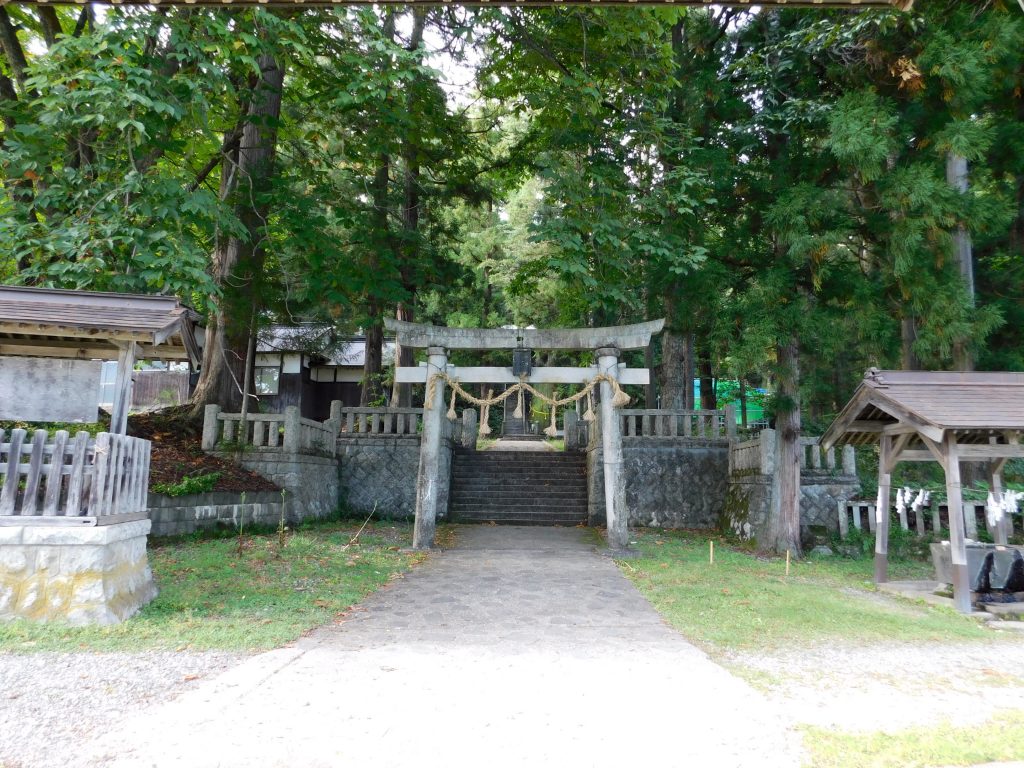
The first thing you notice while approaching this historic Shinto shrine nestled against a hillside is the giant sacred Japanese cedar at the bottom of the staircase. This ancient tree, which even survived a lightning stroke, is estimated to be at least 1,000 years old, and is over 40 meters tall and up to 10 meters in diameter. Surrounded by thirty massive conifers, this sacred tree has been designated a Natural Monument of Hakuba village.
The Hosono Suwa Shrine used to be the destination for villagers to pray for rain in the hope of a rich autumn harvest, but nowadays it’s best-known as the site of the Reitaisai, Hakuba Happo-one’s annual festival, and ninen-mairi, the shrine visit that marks the beginning of a new year.
The Reitaisai, usually in autumn, includes the Yukake Matsuri, a procession that features a portable shrine, which houses a 300 kg–heavy serpentinite rock, carried through the village. The shrine carriers are splashed with hot spring water from Hakuba Happo-one. The spectacle ends at Hosono Suwa Shrine, where everyone can feast on typical festival fare such as yakisoba (stir-fried noodles), butajiru (miso soup with pork and vegetables), and cotton candy— and enjoy lively taiko drumming performances. During ninen-mairi, which takes place between the sun setting on the old year and rising on the new, the premises are beautifully illuminated and often covered by the sparkling white snow. This is the only night when you are able to purchase the coveted lucky charms of Hosono Suwa Shrine.
Since this sacred place is just a five-minute walk from the Adam gondola lift station, stop by at any time of year and take in the mystical atmosphere in this tranquil setting.
Hakuba Museum of Art
Surrounded by lush greenery, this art museum with its Japa- nese-style exterior focuses on works of Marc Chagall—the Russian-French modernist artist dubbed “the magician of colors.” Out of its large collection of nearly five hundred copperplate prints and lithographs, the museum exhibits around one hundred twenty of his best works annually. All of them feature English-language explanations, making it possible for a greater number of people to gain a deeper understanding of each artwork’s meaning.
The interior design with its dimmed lighting and dark-col- ored wooden beams, typical for Japanese-style structures, creates a nice contrast to Chagall’s colorful and modern pieces, while large windows welcome in the abundant nature of the surrounding area. Don’t miss Chagall’s small copperplate prints lining the walls of the museum’s adjoining music room.
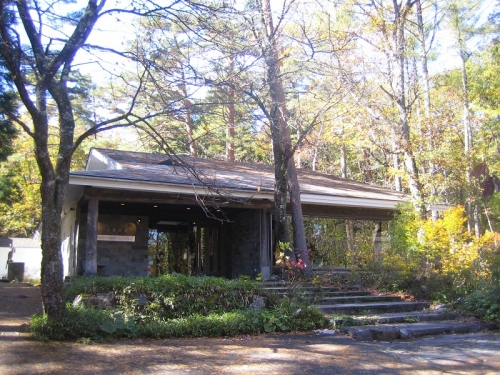
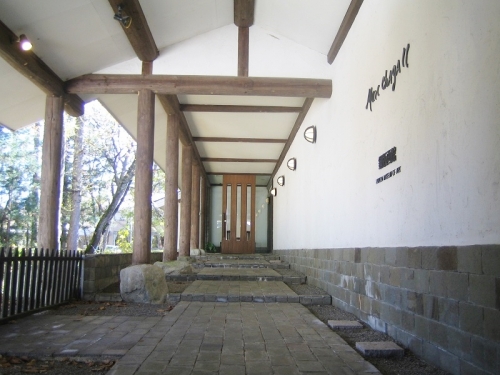
Hakuba Saegusa Art Museum

Set in a beautiful wooden structure resembling Western architectural designs of the early twentieth century, the Hakuba Saegusa Art Museum boasts around one hundred paintings by 80 of Japan’s top artists, including Yayoi Kusama (1929– ), Ikeda Masuo (1934–1997) and Yamashita Kiyoshi (1922–1971). Most of the pieces are inspired by the beautiful scenery of Hakuba and Japan’s Northern Alps throughout the seasons, channeling winter’s crisp air off the snowy mountains or the fresh green grass and colorful flowers in the highlands during the spring.
The museum’s adjoining sunroom provides its own beauty, allowing you to sip on a cup of tea while looking out onto the garden where hundreds of different flowers bloom between spring and autumn, while Japan’s Northern Alps tower in the backdrop. (Note that the museum is open only between April and November).
Tetsuo Kikuchi Alpine Photograph Gallery

Throughout his career, Kikuchi Tetsuo, one of Japan’s leading mountain photographers, captured the natural beauty of Hakuba’s majestic Mt. Shirouma throughout a period of more than 30 years. Admire around 40 of his best works, selected by Kikuchi himself, at this two-story gallery. These large-scale photographs show the mountain during all four seasons—capturing the mountain’s peak surrounded by an ocean of mystical-looking wintery clouds, scenery embraced by pink cherry blossoms during spring, and the autumn foliage reflecting in the mountain’s large Happo Pond.
Kikuchi taught himself the art of photography at the young age of fourteen and devoted his talent to alpine photography six years later. He can look back at an incredible career that encompasses a host of solo exhibitions, as well as two teaching positions at the Nikon College and the Yamakei Culture Club. In 2007, the Tetsuo Kikuchi Alpine Photograph Gallery opened its doors in Hakuba Happo-one’s Wadano no Mori area, in the premises of the Wadano no Mori Church. Before heading over to the gallery, a beautiful brick building with a red roof, purchase your ticket at the little hut located at the entrance to the premises, where you can also grab a coffee or tea.
Hakuba Chapel

Built in 1998, this small contemporary-looking wooden church with its beautiful garden is located in the center of Hakuba village and boasts great views of the Northern Alps. Surrounded by lush greenery in the summer, or nestled deep in the sparkling snow during the winter, it’s a popular wedding destination year-round for both Japanese and international couples.
The Hakuba Chapel is especially famous for the emotional wedding speeches of pastor Mary Hasegawa, who has blessed more than one thousand couples over the last twenty years and continues to do so. A theologian and former pastor in Calcutta under Mother Teresa (1910–1997), Mary came to Japan in 1962. After moving to Hakuba in 1994, she took over the role as a pastor in 1998, the year of the Winter Olympics in Nagano, and remains one of the only female international pastors in Japan.
URL: http://www.hakubachapel.com
Wadano no Mori Church
Nestled in the lush forest of Hakuba Happo-one’s Wadano no Mori, this adorable brick structure with its peaked roof and detached bell tower was built more than 30 years ago. Walk down the little paved path and enjoy picturesque sceneries throughout the seasons, beautiful hydrangeas in the early summer, rustling colorful leaves during autumn, and a white lit-up landscape in the winter. Due to its fairytale setting, the Wadano no Mori Church is a popular wedding location among Japanese and international couples alike—and at certain days of the year, visitors can even enjoy classical concerts amidst this romantic and cozy atmosphere.
Directly next to the bell tower you can find the Tetsuo Kikuchi Alpine Photograph Gallery, which exhibits breathtaking large-scale images of Mt. Shirouma taken by famous mountain photographer Kikuchi Tetsuo. For those who want to stay a little bit longer in this tranquil ambience, sit down in front of the little hut next to the entrance and enjoy a cup of freshly brewed coffee or tea.

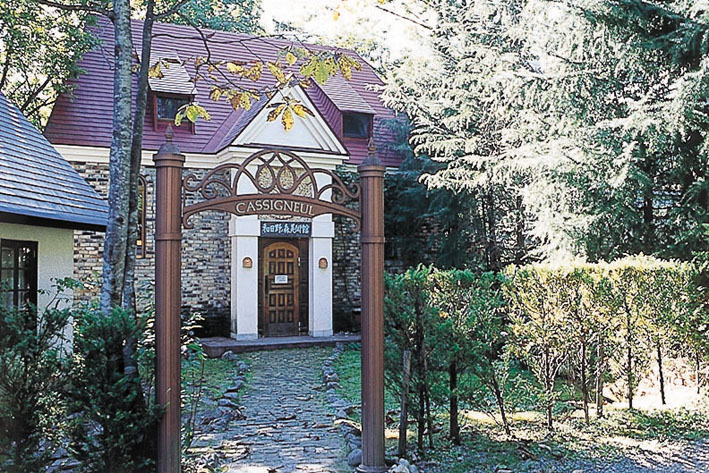
The Beginning of Japanese-Style Guest Houses

Typical Japanese-style guest houses run by families, known as minshuku, are a great way to experience traditional hospitality without breaking the bank. Usually to be found in villages, minshuku are usually spare rooms in family homes. The concept of this housing style began in Hosono (modern-day Hakuba Happo-one) during the first half of the 20th century, and is deeply connected with the village’s history of mountain climbing.
Until the end of the Edo period (1603–1867), Happo-one’s Shirouma mountain range was believed to be a sacred site and climbing was forbidden. After the Meiji Restoration at the end of the 19th century, regulations loosened and Mt. Shirouma and its surrounding peaks were finally measured and opened up to explorers and geologists, botanists and famous mountaineers flocked to the area. One was the British pastor and mountaineer Walter Weston. Considered the “father of mountaineering in Japan,” he conquered Mt. Shirouma in 1894 and assembled his impressions in the book Mountaineering and Exploration in the Japanese Alps (1896). The popularity of Weston’s book, along with the publication of 50,000 topographic maps of the mountain site in 1913 and the connection to the Shinano Railway three years later, making it possible to visit directly from Tokyo, combined to draw more and more mountaineers to Happo-one.
To accommodate the adventurers, a number of guides offered visitors the opportunity to spend the night at their own houses, instead of staying at a ryokan (typical Japanese inn). In 1937, sixteen houses of local guides in Hosono gained permission to provide lodging for travelers—marking the beginning of the minshuku business. The area rapidly developed into a ski and mountain resort in 1948, and about ten years later 295 individual minshuku provided accommodation for about 13,000 guests.
Hakuba Alpen Library
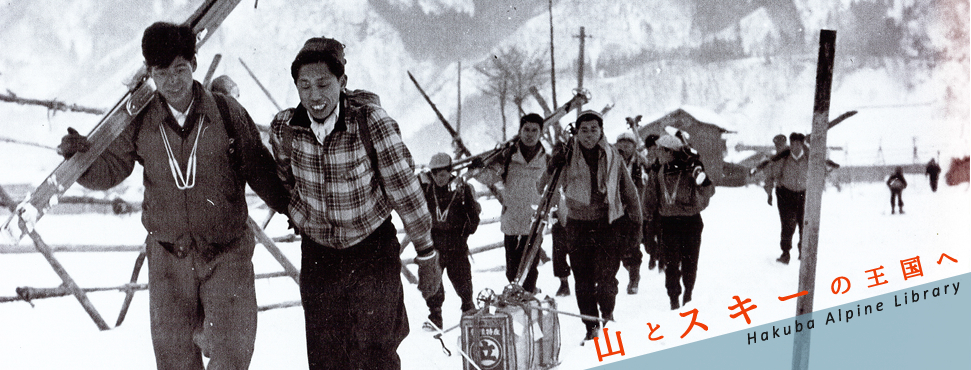
The Hakuba Alpine Library, conveniently located in the premises of the central bus terminal and information center, is the perfect place to learn about the history of Hakuba Happo-one. Established in 2010, the facility has exhibitions in English and Japanese exploring mountaineering and skiing in the area, historical rural life in the region, and the life story of Fukuoka Takayuki, the founder of the Riesenslalom (Giant Slalom) course. There is a large selection of Japanese- and English-language publications allowing people to dive deeper into these subjects.
Exhibition About the Relationship Between Mountaineering and Skiing
The deep connections between mountaineering and skiing are explored in this sixteen-booth exhibition with information provided in both Japanese and English. Find out about the first attempts at mountain climbing in the beginning of the Meiji period (1868–1912), learn about the concept of minshuku, Japanese-style guest houses run by families, and learn how skiwear changed throughout the decades. The section dedicated to the Nagano Winter Olympics 1998 is a particular highlight, with photographs and memorabilia of the time all eyes were on Hakuba Happo-one.
Fukuoka Takayuki Memorial Exhibition
This exhibition celebrates the life of Fukuoka Takayuki (1913–1981), a former professor of German language and of the theory of physical education at Hosei University. To many he is the founding father of Hakuba Happo-one’s ski scene. Fukuoka dedicated a great deal of his life to skiing and mountain climbing, having discovered the sports while training to be an athlete. Fukuoka published his own book about different skiing techniques, based on his own experiences and observations.
Having resettled to Hosono (modern-day Hakuba Happo-one) shortly before World War II (1939–1945), Fukuoka discovered the area was the perfect place to establish a run for downhill and slalom skiing. After convincing the local government by explaining the benefits of this new project, the construction works for the Riesenslalom (Giant Slalom) Course started and the first tournament was held in 1947.
History Corner
Travel back in time and discover the many different traditional farming tools and techniques used by the locals over one hundred years ago. The history corner also houses a life-size diorama of a typical fireplace found in traditional Japanese farm houses.
Mountain and Ski Library
Here you can leaf through more than 10,000 different Japanese- and English-language publications related to mountains, mountain climbing, and skiing.
Happo,Kitashiro,Hakubamura, Kita-azumigun ,Nagano 399-9301
Tel:(+81)-261-72-3066
